Authorized Images: Famous Authors Seen Through Antique and Vintage Postcards
Authorized Images is an eye-mesmerizing survey–the first of its kind anywhere—examining the worldwide phenomenon when the planet went mad for picture postcards associated with novelists, poets, and playwrights—to a degree almost inconceivable to us now. The craze started in the early 1890s and tapered only in the 1930s with the arrival of the Great Depression.
In the first decades of the 20th century, the mania for sending literary postcards through the mail was equalled only by the mania for collecting postcards as a hobby. Savvy publishers of postcards fomented greater purchases of their product by supplying free albums in which collectors could display and store their growing compilation of treasures. The craze resulted in the sale of millions of literary postcards throughout the western world.
To modern eyes, there seems to have been an insatiable hunger for these easily-affordable images of writerly figures, most of them celebrated–even venerated to a degree scarcely credible today.
Table of Contents:
1. Authorized Images: Omnibus Edition
1.1 Omnibus Edition Volume 1: Wish You Were Here
1.2 Omnibus Edition Volume 2
1.3 Omnibus Edition Volume 3
1.4 Omnibus Edition Volume 4
1.5 Omnibus Edition Volume 5
2. Authorized Images: Spotlight Editions
2.1 Dante Alighieri
2.2 William Shakespeare
2.3 Johann von Goethe
2.4 Friedrich Schiller
2.5 Charles Dickens
2.6 Mark Twain
2.7 Gabriele D’Annunzio
2.8 Colette and Anatole France
2.9 Daniel Defoe and Andrew Marvell
2.10 Robert Burns and Sir Walter Scott
2.11 Miguel de Cervantes and Luis de Camões
2.12 Leo Tolstoy and Mikhail Lermontov
2.13 Rudyard Kipling and Hall Caine
2.14 Bjørnstjerne Bjørnson and Franz Grillparzer
2.15 Alexandre Dumas, père and Gustave Flaubert
2.15 Jane Austen, George Eliot, Charlotte Bronte, Anne Bronte
2.15 Molière, Corneille, Beaumarchais, Abelard
Authorized Images: Omnibus Edition
More details about each volume of the Omnibus Edition:
Omnibus Edition Volume 1:
Introduction to (and History of) Literary Picture Postcards
An extensive history of the evolution of what we now term “antique postcards”.
Volume One of Authorized Images is 535 pages in length and includes 408 antique postcards and vintage illustrations. It concentrates on the explosion of public fascination with postcards (in the decades either side of 1900), particularly those affiliated with literary figures. On a massive scale, postcards of this kind suddenly appeared everywhere in the developed world, a craze that continued until the 1930s.
Volume One of Authorized Images is a comprehensive history of how the picture postcard came into existence. This is the longest and most in-depth account of how the picture postcard came into existence, with a special emphasis on the origins of literary postcards.
Volume One offers an overview of printed paper collectables which were the immediate ancestors of picture postcards.
These antecedents include, for instance, the carte-de-visite, greeting cards, trading cards, and printed envelopes.
The survey of postcard history then becomes more focussed, detailing the specific emergence of the literary postcard, a category which includes, naturally, portrait busts of authors, but, in addition, images of their homes, schools, graves, statues, relatives, lovers, monuments, as well as depictions of characters and scenes from their writing.
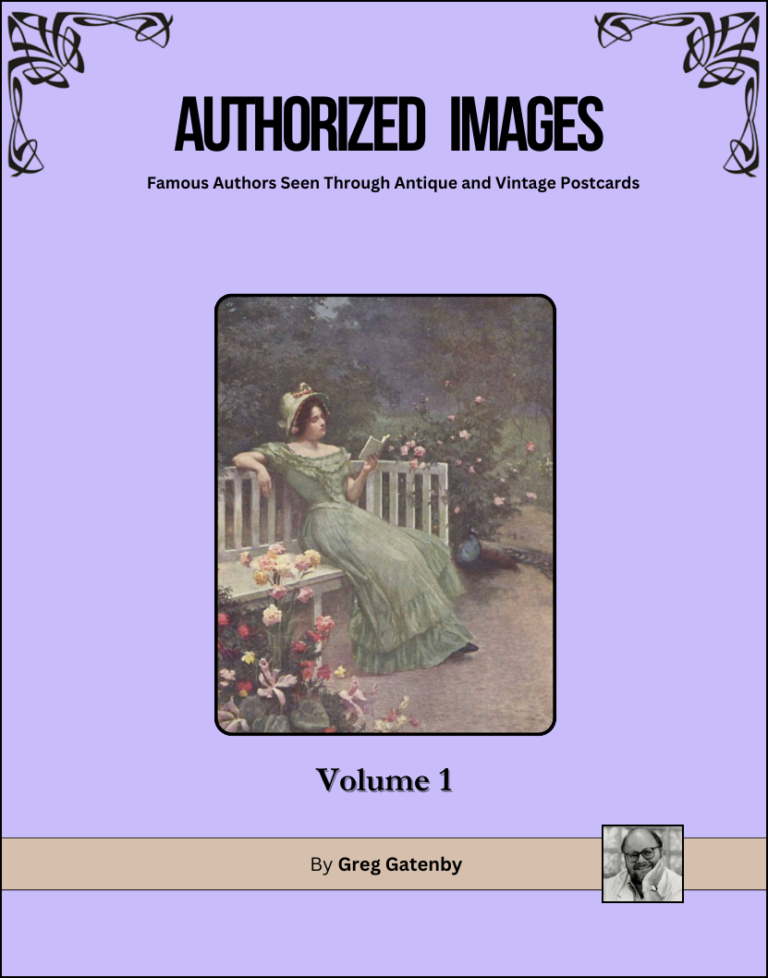
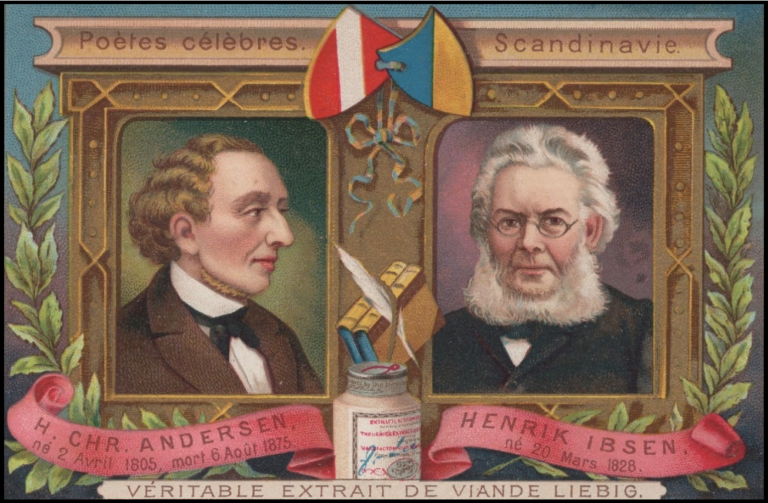
Trading Cards emerged in the mid-1800s, a few decades prior to postcards. They were generally offered free by food and tobacco producers as a reward for buying their products. The proportions of Trading Cards and their graphic artwork allowed for their easy transfer to the postcard format.
Above is a trading card, ca 1870, featuring the Scandinavian literary giants Hans Christian Andersen and Henrik Ibsen.

Elizabeth Barrett trading card, a late 19th c. precursor of literary postcards which later featured the same portrait. Also from the late 19th c. were tobacco trading cards , such as the example above, of English poet Elizabeth Barrett Browning. The same photographic negative was recycled by printers who, ca 1900, began to issue this image on pioneer postcards.
During the last years of Queen Victoria’s reign, cigarette makers inserted small trading cards like the one above of Elizabeth Browning into their thin paper packs with the hope that smokers (or their children) might start to collect all the cards in a series.
Tobacconists issued several different series of cards. One set might depict royals, another military men, yet another animals of a certain type—and almost every tobacco brand had a series devoted to authors. The cards not only induced people to buy ever more cigarette packs, with the hope of assembling a complete set of the series devoted to literary figures—the trading cards also helped to stiffen the packaging, preventing the cigarettes inside from being crushed in a purse or pocket.
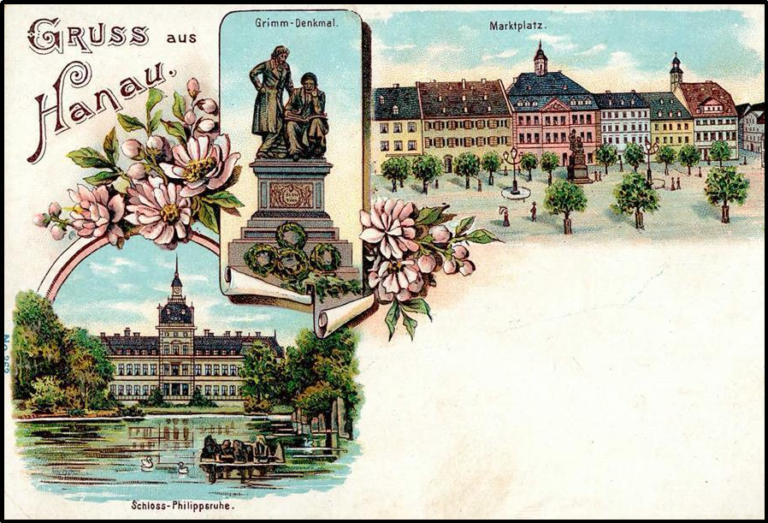
The first widely available picture postcards were printed via colour lithography. They usually featured 2, 4, or even more vignettes of sites important to tourists. Inevitably, a monument to a famed local writer was included among the vignettes (as above, showing the Brothers Grimm). Indeed, statues of authors were often more numerous on such postcards than were bronze or marble monuments of royals or commanders.
The white patch on this card (ca 1898) was the only space where a message could be written. The back of the postcard, until 1903 in most countries, was reserved–by law–solely for the recipient’s address.

A postcard vendor, ca 1900, selling his wares to passers-by at locales popular with tourists.
To enhance sales, postcard shops, especially at favourite tourist destinations, hired men and children to carry a small array of relevant postcards on a sandwich board. The sellers were expected to be polite but aggressive in compelling visitors to buy.

World War One put an end to most international tourism but, if anything, led to an increase in the number of postcards sent through the mails. Why? Because millions of soldiers, sometimes daily, sent postcards home to loved ones.
Almost every soldier was equally hungry to receive postcards at the same rate. Often, the pictures on the postcards no longer featured attractive cityscapes but instead were of a martial or patriotic character. Even so, patriotic postcards from the Great War era frequently abound with patriotic sentiments and sayings, most of them quotations from the works of famous poets and creative writers, such as this example citing the Italian nationalist author Gabriele D’Annunzio
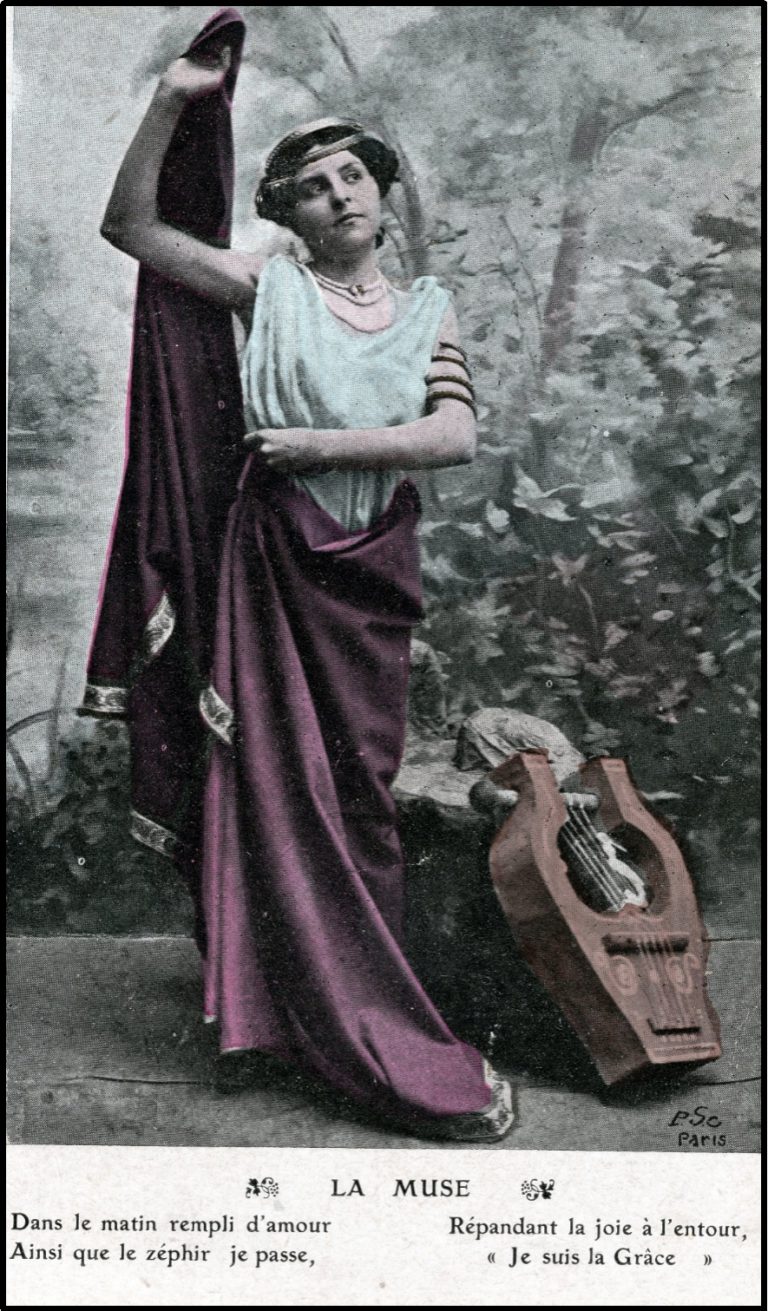
From the first years of the 20th c. publishers would grab at any excuse to show what was then termed a “pretty lady”. Above is one of a set of six such postcards, all portraying a Muse of the various arts.

A large sub-category of literary postcards is that which depicts people, usually women, taking pleasure from reading a book.
Thousands of such cards were produced around the world in the decades immediately after the invention of the picture postcard The example above is not exceptional in equating reading with glamour.

Prior to the invention in the 1920s of the conventional greeting card, as we know it today, one that opens like a four-page book, people sent good wishes for a religious or secular holiday via appropriately-themed, illustrated postcards. The example above hails from about 1904, its highbrow intent heightened by the inclusion of a quotation from Lord Alfred Tennyson, the renowned Poet Laureate of England.
Adding literary references to such cards was a common device of publishers during the early years of the postcard craze, the purpose being to make the card seem more elevated in tone.
Omnibus Edition Volume 2:
Volume 2 of Authorized Images is an examination of several renowned writers, including Dante, Shakespeare, Goethe, and Molière. In all, there are 11 authors discussed at length in this volume.
Below are a a few of the postcards presented and examined in Volume 2 of Authorized Images:
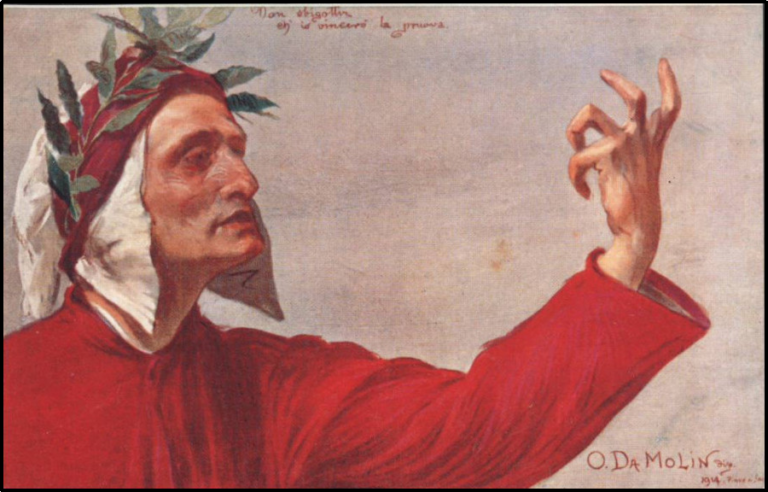
As no certain portrait of Dante has survived, artists were free to create their own image of the man. In 1894 the Italian painter Oreste da Molin (1856-1921) painted this highly Mannerist yet fetching portrait of Dante. The current whereabouts of the original canvas are unknown. The depiction was reproduced on postcards as early as 1910, the approximate date of the example above.

Postcard, ca 1905, reproducing an image by George Cattermole (1800-1868) of Shakespeare relaxing with friends in the backyard of the grand property bought by The Bard in Stratford with the wealth he had accumulated from his theatrical work in London. The original of this picture is one of a baker’s dozen watercolours made by Cattermole to illustrate key stages in the famed dramatist’s career. Cattermole was asked to create the pictures in the 19th c. by a scholar about to deliver a major public lecture on the life of Shakespeare. The watercolours were donated in 1901 to Stratford’s Shakespeare Memorial Theatre.
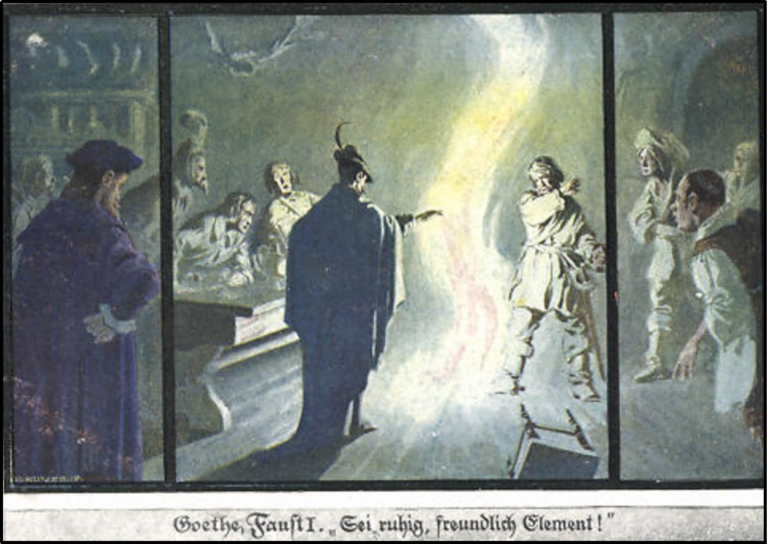
In the play Faust by Goethe, Mephistopheles, disguised as a dog, follows Faust while the drama’s hero is out for a walk in the countryside. The satanic canine pursues Faust into the man’s home and there — presto! — the hound transmogrifies into the demon Mephisto. The moment is captured by an unknown Victorian artist who has, unusually for the era, made his canvas a triptych. The image was apparently made at the request of the postcard publisher. The card itself dates to about 1903.

Authors in Authorized Images Volume 2:
Dante Alighieri (1265-1321)
Geoffrey Chaucer (ca 1340-1400)
Ludovico Ariosto (1474-1533)
Miguel de Cervantes (1547-1616)
William Shakespeare (1564-1616)
Molière (1622-1673)
Johann von Goethe (1749-1832)
Jane Austen (1775-1817)
James Fenimore Cooper (1789-1851)
Edgar Allan Poe (1809-1849)
George Eliot (1819-1880)
Acknowledgements
Omnibus Edition Volume 3:
Volume 3 of Authorized Images features extensively illustrated profiles of Robert Burns, Friedrich Schiller, and Lord Byron along with 13 others.
A sampling of postcards from Volume 3 follows:
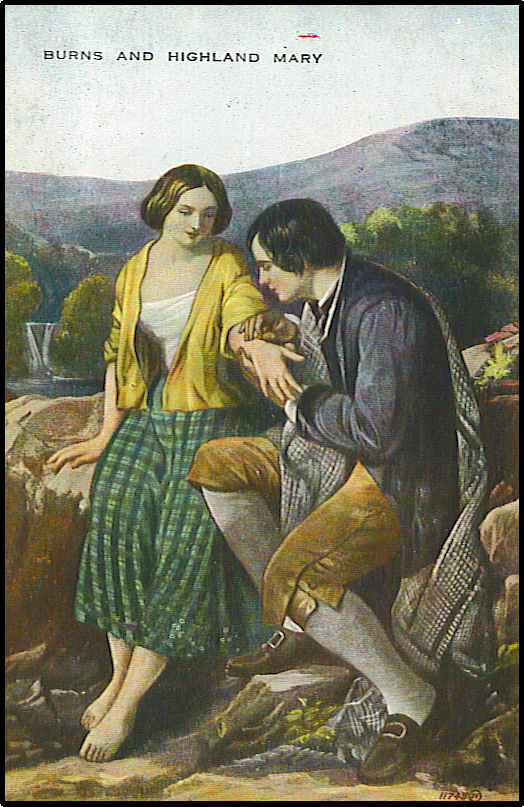
Above is a postcard of the mutually smitten young lovers Robert Burns and Mary Campbell—smitten (as far as Burns was concerned), for the months of April and May of 1776, after which his romantic attentions were directed further afield.

A handsome postcard in the Art Nouveau style, published in 1905 on the centennial of the death of German literary giant Friedrich Schiller.
Authors in Authorized Images Volume 3:
Aeschylus (525–455 BC)
Pietro Aretino (1492-1556)
Luís de Camões (ca 1524-1580)
Jean de La Fontaine (1621-1695)
Daniel Defoe (ca 1660-1731)
Pierre Beaumarchais (1732-1799)
Robert Burns (1759-1796)
Friedrich Schiller (1759-1805)
George Gordon, Lord Byron (1788-1824)
William Cullen Bryant (1794-1878)
Honoré de Balzac (1799-1850)
Ralph Waldo Emerson (1803-1864)
Charles Dickens (1812-1870)
Charles Baudelaire (1821-1867)
Leo Tolstoy (1828-1910)
Hall Caine (1853-1931)
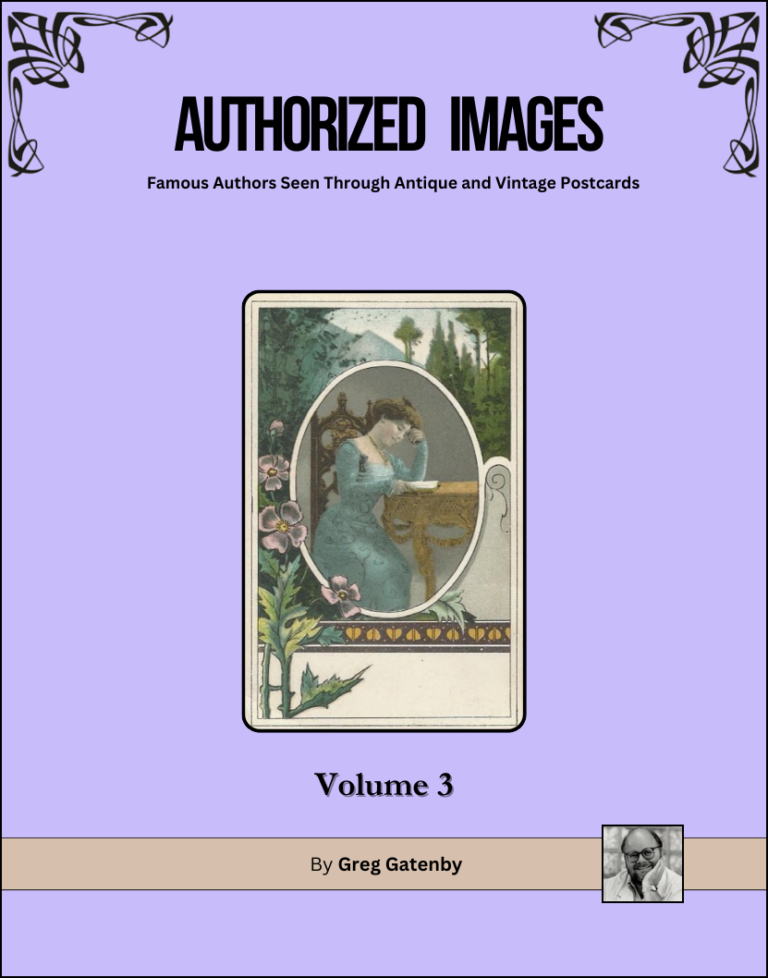
Omnibus Edition Volume 4:
Volume 4 of Authorized Images contains substantial treatments via text and illustration of Homer, Hans Christian Andersen, and Charlotte Bronte in addition to a dozen others.
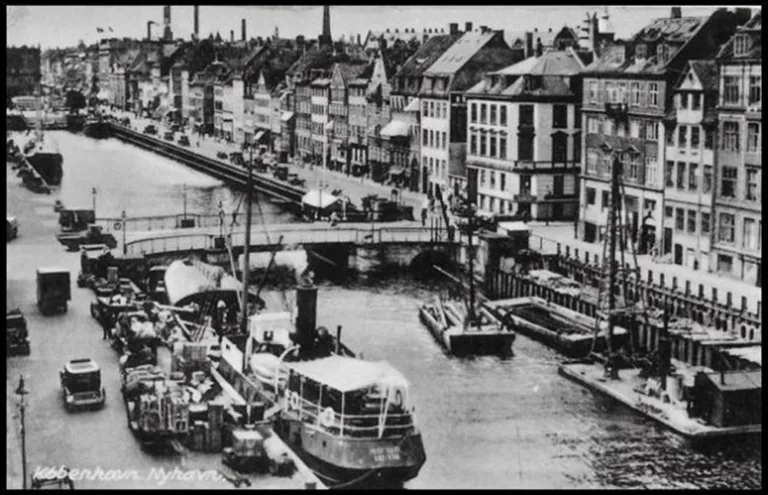
Copenhagen, Nyhavn Street, in the early 1900s, much as it would have been when Andersen lived here.
Although he was earning goodly sums in royalties from his writing, Andersen chose to be abstemious in the extreme, renting walk-up flats only.
On this street he lived in three different apartments: at Number 20 (then number 280) he lived from 1834 to 1838. He later resided at number 67 from 1848 to 1865. Then in 1872 he moved to number 18. Only the edifice at 20 Nyhavn has a plaque on its façade alerting passersby that this was once the home of the country’s most famous author”

Homer portrayed by Pier Francesco Mola (1612-1666) on an early Soviet-era Russian postcard.
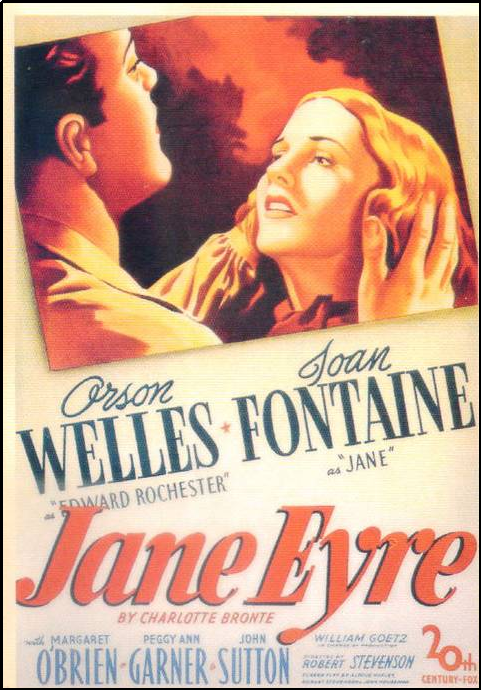
It should not be too surprising that one of the great love stories of English literature has inspired movie makers over the decades. The postcard above promoting the 1943 version of Jane Eyre, starring Orson Welles and Joan Fontaine, has its defenders—but equally vocal are those who prefer any of the other 15 feature-length films based on the novel.
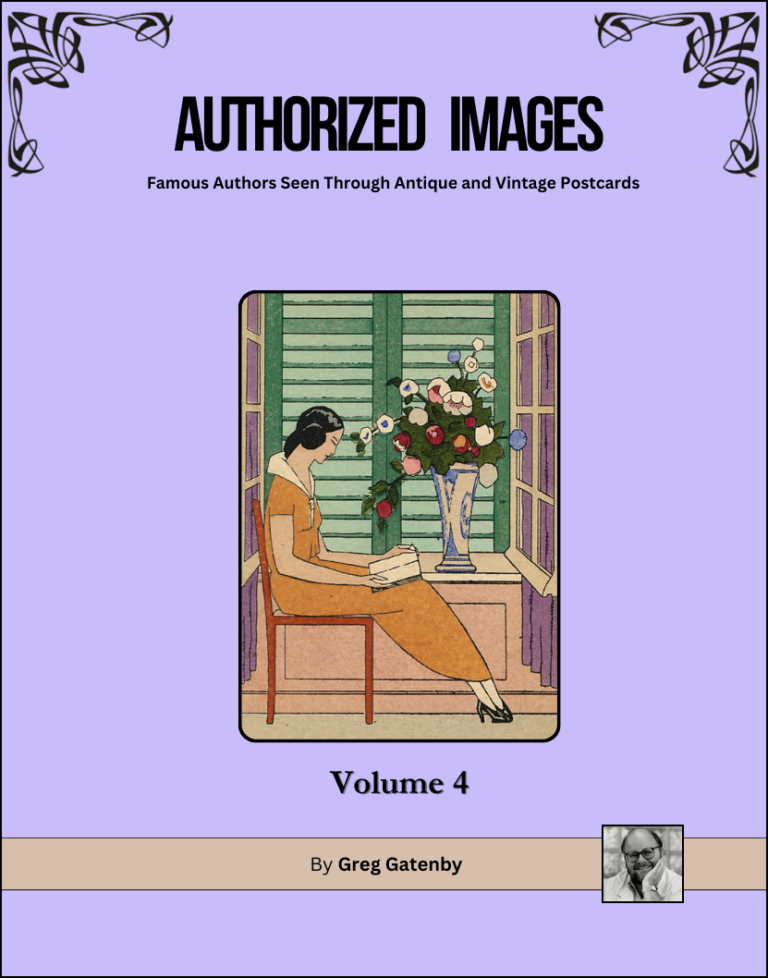
Authors in Authorized Images Volume 4:
Homer (fl. 8th c. BC)
Caedmon (fl. 657-684)
Pierre Abelard (1079-1142)
John Milton (1608-1674)
John Bunyan (1628-1688)
Sir Walter Scott (1771-1832)
John Keats (1795-1821)
Alexandre Dumas, père (1804-1864)
Nathaniel Hawthorne (1804-1864)
Hans Christian Andersen (1805-1875)
Elizabeth Barrett-Browning (1806-1861)
and Robert Browning (1812-1889)
Charlotte Brontë (1816-1855)
Walt Whitman (1819-1892)
Emily Dickinson (1830-1886)
Louisa May Alcott (1832-1888)
Bjørnstjerne Bjørnson (1832-1910)
Mark Twain (1835-1910)
Sholom Aleichem (1853-1916)
Rudyard Kipling (1865-1936)
Colette (1873-1954)
Scott Fitzgerald (1896-1940)
Oren Arnold (1900-1980)
Omnibus Edition Volume 5:

Sappho by French visual artist James Pradier (1790-1852). He was in such high demand as a sculptor, regardless of which regime was in power, that he and his workshop could barely keep pace with the commissions he received. Today he is regarded as one of the finest Neo-Classical artists who worked in France in the 19th c. His final statue was this compelling image in marble of Sappho, completed mere weeks before his death. The postcard above dates to ca 1905.

Statue of Flaubert in Rouen by Léopold Bernhard Bernstamm (1859 –1939), a native of Germany but active primarily in France and Russia.

Based on the numbers which survive, this was a very popular postcard when it was issued in the 1920s in black and white. This colorized version appeared first in the 1960s. The setting is aboard a fast motorboat cruising on Lake Garda when Mussolini paid a visit to D’Annunzio’s lakeside home on May 25, 1925.
Authors in Authorized Images Volume 5:
Sappho (ca 630–ca 570 BC)
Giovanni Boccaccio (1313–1375)
Torquato Tasso (1544-1695)
Pierre Corneille (1606-1685)
Andrew Marvell (1621-1678)
Franz Grillparzer (1791-1872)
Percy Bysshe Shelley (1792-1822)
Henry Wadsworth Longfellow (1807-1882)
Mikhail Lermontov (1814-1841)
Henry David Thoreau (1817-1862)
Anne Bronte (1820-1849)
Gustave Flaubert (1821-1880)
Matthew Arnold (1822-1888)
Thomas Hardy (1840-1928)
Anatole France (1844-1924)
J.M. Barrie (1860-1937)
Gabriele d’Annunzio (1863-1938)
Agatha Christie (1890-1976)
Ernest Hemingway (1899-1961)
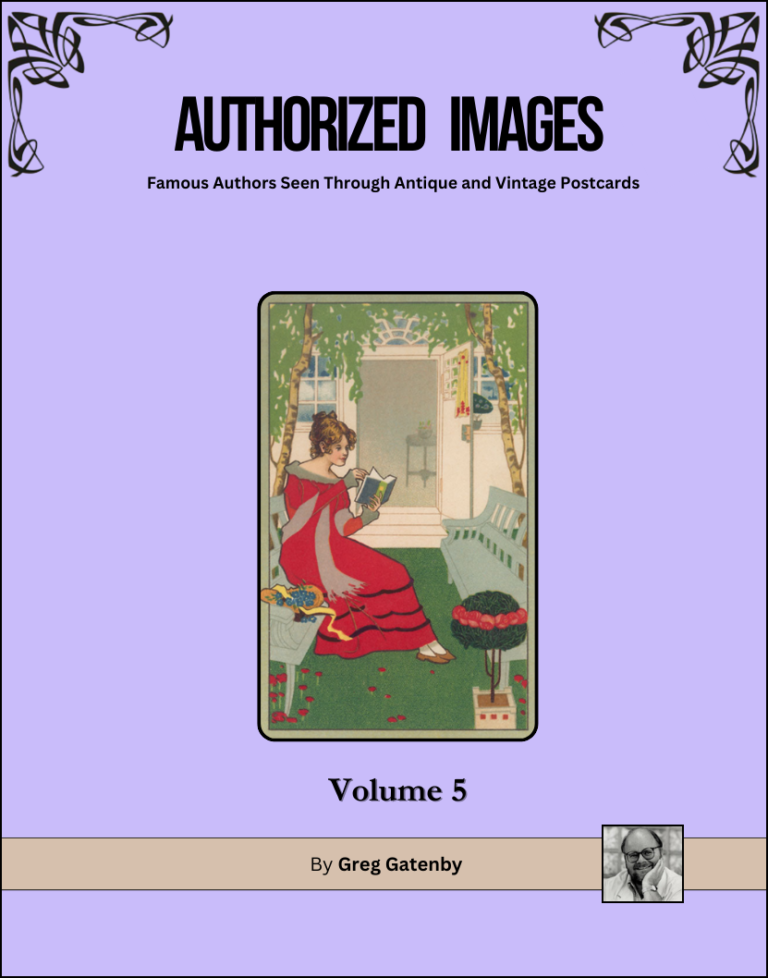
For those for whom the Omnibus edition is too rich a banquet we invite you to consider the Spotlight Series.
These Spotlight books contain the same text and pictures regarding individual authors as the Omnibus edition—although note that each volume of the Spotlight Series is limited to discussion of just one, two, or a small handful of authors. Nonetheless, some of the Spotlight titles contain thousands of words of explanatory text, accompanied by hundreds of reproductions of vintage literary postcards.
Authorized Images: Spotlight Edition
Details about the volumes in the Spotlight series, each volume focussing on a single author—or a small group of like authors:
Authorized Images: Dante Alighieri
(141 pages, including 120 antique postcards).
$14.99

Authorized Images: William Shakespeare
(281 pages, including 250 antique postcards).
$24.99
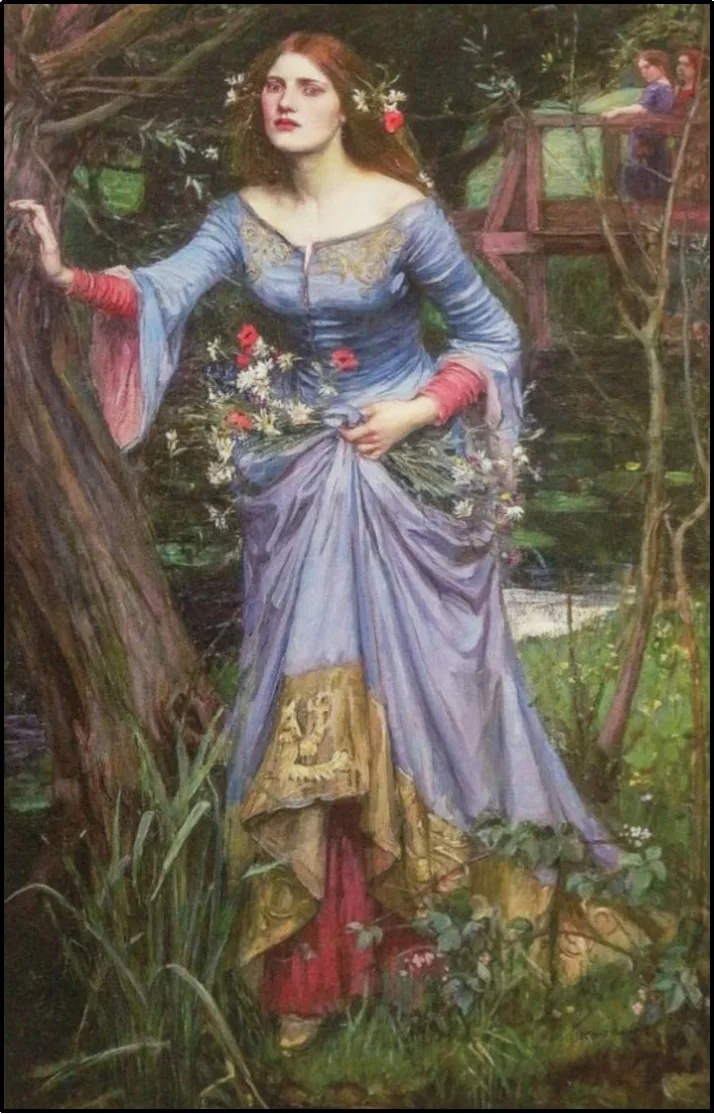
A portrait of Ophelia, by John William Waterhouse (1849–1917). Waterhouse was renowned in his day throughout England for his portrayals of young women. Most of his subjects were females from mythology or were characters from the works of authors ancient and moderns, writers such as Homer, Ovid, Keats, Tennyson—and Shakespeare. While not officially a member of the Pre-Raphaelite Brotherhood, he was persuaded by their aesthetic arguments to quit the Academic style then prominent in art circles and adopt the Pre-Raphaelite approach, as is evident in this 1910 depiction of Ophelia.
He made two other portraits of Ophelia: one in 1888 and one in 1894. The postcard above dates to ca 1908.

Statue to Shakespeare by John Cheere and Peter Schaemakers adorning the street façade of the Town Hall of Stratford-upon-Avon. The text carved into the stone tablet cites how the aldermen of Stratford oversaw the evolution of the project. Then, almost as an afterthought, there is a mention on the inscription that David Garrick paid the costs for the making of the statue.
By the way, the clothing in which Shakespeare is dressed is hardly Elizabethan. Rather, the vestments represent what those in the eighteenth century were sure was the menswear prevalent when Shakespeare was alive. The original, relaxed pose invented by Schaemakers for his likeness of Shakespeare remains so popular with the public that it can claim to be the figure of the Bard reproduced full-figure more often in postcards and books than any other statue.

This postcard of the Otto Lessing (1846-1912) statue of Shakespeare was probably published ca 1920.
The size of the statue can be deceiving from a perspective such as this. The marble figure alone is over two meters (6.5 feet) high. The pedestal is a further 1.4 meters (5 feet) high.
The statue resides in a bucolic setting in one of the oldest parks in Germany, the Park an der Ilm. Appropriately enough, this park was designed in the 1780s by Johann von Goethe in the style of an English landscaped garden. It has remained essentially unchanged since the German sage designed the park. The literary credentials of this spot are enhanced by the presence of busts of four other internationally acclaimed poets (unfortunately not visible in this view): Russian Alexander Pushkin, Hungarian Sandor Petofi, Pole Adam Mickiewicz, and Czech Louis Furnburg.
Authorized Images: Johann Wolfgang von Goethe
(373 pages, including 315 antique postcards).
$24.99
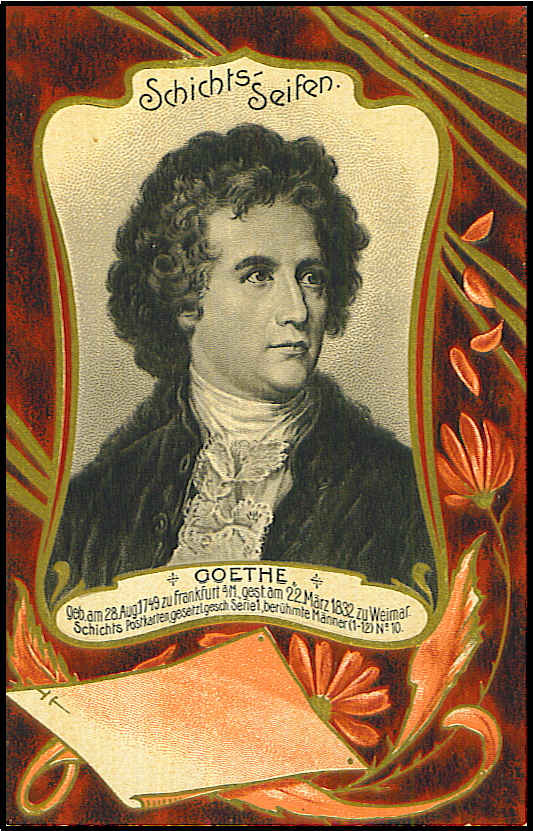
This image, with its attractive Art Nouveau features, owes more than a little to the Angelika Kauffmann portrait of the writer. The painting above was undoubtedly the work of an anonymous artist working under contract to the publisher.

Surely one of the traits of postcards issued on the Continent in the early 1900s, in contrast to those in the Anglophone world, is that the latter were highly unlikely to publish any postcard of a place whose only claim to fame was that it was where a famous author had had illicit rendezvous with a married woman.
Above is a German postcard of a tower (known as a garden house in the German language) on the property near Frankfurt owned by the husband of Marianne von Willemer. The poet and his inamorata would discreetly arrive separately at the building, climb to the top floor, admire the view over the surrounding countryside, talk, and make love, not necessarily in that order. The postcard seen here, dating to ca 1904, was hardly unique.
Several variations exist, all with cameos of Goethe’s lovers, and the captions containing nary a word of reprobation or disapproval of their illegal activity. Publishers in the far more prudish Anglosphere never issued postcards showing the lovers (particularly adulterous lovers) of famous British or American authors.

The “Dies irae” [“Day of Wrath”] is a 13th c. Latin poem sung during a Requiem Mass at a Roman Catholic service. It has been set to music by several composers—perhaps most famously by Verdi. However, in Goethe’s time the version by Mozart would have been among the most heard.
Gretchen has gone to church to try to atone for her sins: she gave a sleeping potion to her mother so that she could be alone with her lover Faust, but the potion was so powerful it poisoned her parent.
Then, due to her intimacies with Faust, she became pregnant. Her brother, outraged at what he regarded as Faust’s violation of his sister’s honour, challenged Faust to a duel. In the ensuing swordfight the brother was slain by Faust. Tortured beyond bearing by Mephisto’s telepathic taunts while she is in church, Margarete faints while trying to pray. This postcard dates to about 1902 and is hand tinted.
Authorized Images: Friedrich Schiller
(193 pages, including 186 antique postcards).
$24.99

Schillerstein is the name of an enormous, chimney-shaped rock jutting more than 60 feet (20 meters) from Lake Lucerne in Switzerland.
In the 1850s, as the centennial approached of Schiller’s birth, authorities of nearby cantons decided to honour the dramatist by roughly carving the rock into the shape of an obelisk, then chiseling into it a brief inscription paying homage to the poet, the words accentuated with gold leaf.
Unfortunately, the sculptural work on the rock took longer than expected and the official inauguration did not happen until 1860. This postcard dates to ca 1904.
Good views of the rock are available only from the water–yet this apparent impediment seems to make the monument only more attractive to tourists. More than 150 years after its creation, the Schillerstein remains one of the most popular tourist destinations in Switzerland.

As Mannheim was where Schiller had his first literary success, it seems fitting that the city commissioned a statue of Schiller.
In 1862 the work was installed in front of what was then the National Theatre. Appropriately, the square is now called Schillerplatz.
The bronze statue was made by Karl Ludwig Cauer (1828-1885) and his portrayal of a young, virile, confident yet casual Schiller is generally considered the sculptor’s masterpiece.

A scarce postcard combining lithographic printing with offset photographic presswork. This singular example was issued in 1905 to mark the centenary of Schiller’s passing.
Authorized Images: Charles Dickens
(152 pages, including 136 antique postcards),
$14.99

This ca 1903 postcard recycles the original portrait made in 1860 from a wet-plate negative by Herbert Watkins (1828-1916).
In 1856 Watkins established his studio on Regent Street in London where he photographed a high number of well-known people, particularly politicians and those in the arts. In 1858 he published “National Gallery of Photographic Portraits”, a selection of 28 depictions in a deluxe, limited-edition book.
In addition to the albumen photos, the book included biographical notes about each sitter, copies of letters and autographs of each sitter—and, most extraordinarily, copies of letters from eminent folk who refused Watkin’s invitation to sit for him. One gains a sense of Watkins’ confidence in his work by a brief quote from his prospectus for the volume.
He described his portraits “as remarkable for their agreeable fidelity to nature as for their brilliancy of production and their economy of cost”. Other literary authors included in the portfolio were Louisa Stuart Costello, Thomas Chandler Haliburton, Walter Savage Landor, Thomas Babington Macaulay, and Richard Chenevix Trench.
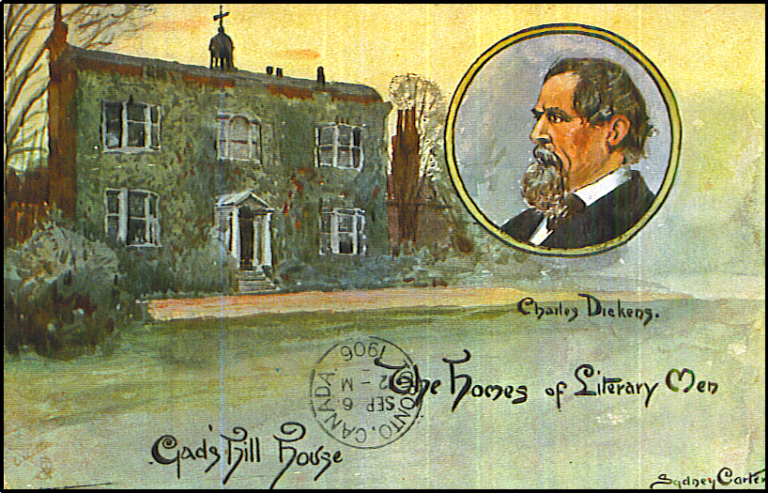
Authorized Images: Mark Twain
(152 pages, including 149 antique postcards).
$14.99

A ca 1909 postcard of the cabin in Florida, Missouri where Mark Twain was born, with a cameo of the author.

An American postcard of The Mark Twain Zephyr, as portrayed in this advertising postcard issued at the time of the vehicle’s launch in 1935. This train was unusual in several respects.
Most notably, it was fully articulated, meaning that the locomotive and the three coaches behind were all joined in such a way to maximize its aerodynamic qualities.
This design certainly made the train look exciting and flashy by the standards of other railroad engines of the day. However, the design permitted no extra passenger cars to be added during busy periods.
When the train’s scheduled service was terminated in 1958, this inability to add additional wagons full of paying customers was a major element of its demise. The shortcomings of the design became especially evident, just as the American Interstate Highway system was nearing completion.
The vastly improved network of roads across the continental United States allowed more people to drive their cars at a time and pace of their choosing–rather than be constricted by the schedule of trains such as the Mark Twain Zephyr. While it was in service, the Zephyr routinely did make a stop in Hannibal.
Authorized Images: Gabriele D’Annunzio
(196 pages, including 140 antique postcards).
$19.99
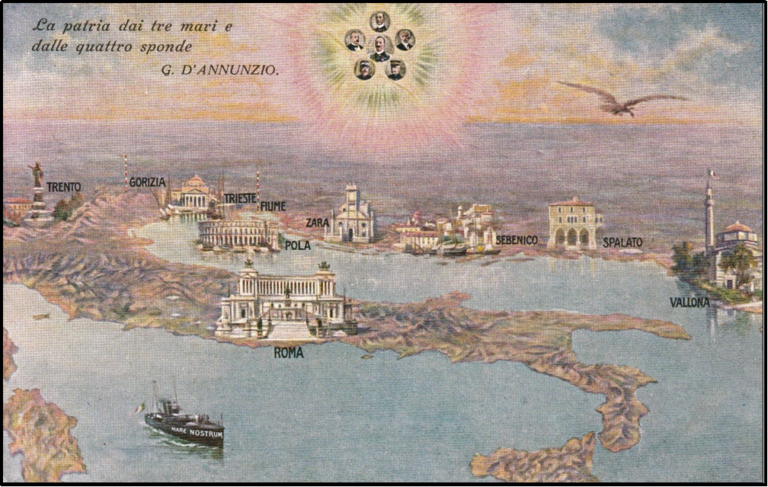
A postcard issued around the end of World War One illuminating the fantasy of many Italians that their country would be awarded (by the Allied diplomats in Versailles re-drawing international borders) the entire eastern shore of the Adriatic that had been the only seacoast of the Austro-Hungarian Empire—thus transforming the Adriatic Sea into an Italian lake. To reinforce the delusion, the postcard above carries a quotation by Gabriele D’Annunzio, at the time the foremost exponent of Italians having a “natural” right to the disputed land of the Dalmatian coast.
(46 pages, including 51 antique postcards).
$14.99
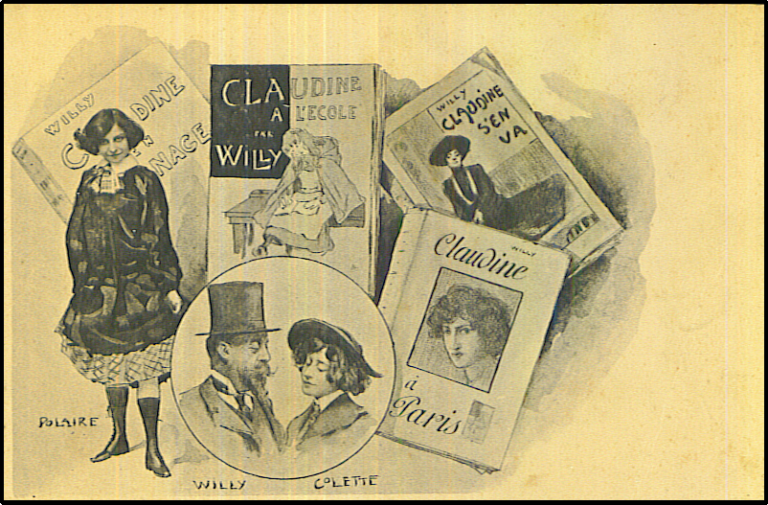
Above is an extremely rare French postcard, undoubtedly issued as a promotional vehicle by Colette’s book publisher. Its undivided back means that it was published in 1903 or earlier when Colette was still married to Willy–but just starting to emerge from under his shadow. The actor Polaire had also just started to make her name in the world of theatre—primarily as the star of stage adaptations of Colette’s increasingly popular Claudine novels. Note how the publisher decided to hedge his bets by including a cameo of the bestselling author Willy in the company of his wife Colette.
Authorized Images: Daniel Defoe and Andrew Marvell
Daniel Defoe (18 page4s, 15 antique postcards); Andrew Marvell (6 pages, 5 antique postcards). $9.99
$9.99

Friday falls in fear upon seeing Robinson Crusoe for the first time, a drawing by Paul Gavarni (real name: Guillaume Chevalier; 1804–1866). The pose, though hardly politically correct today, would have passed as natural in an age when white imperial nations were beginning their conquests (and religious conversions) of foreign colonies.
Gavarni was a late bloomer as an artist, pursuing a career in the arts only when he was in his thirties. Soon he was drawing satirical sketches for the humour magazine Le Charivari to which Daumier, Grandville, and Doré, some of the greatest black-and-white specialists in French art history, were ongoing contributors.
In those same years he also supplemented his income by illustrating short stories and novels appearing serially in periodicals. His work was so fine book publishers began asking him to provide pictures (then a common practice) for novels by authors as popular as Balzac and Eugene Sue. This postcard above first debuted about 1904.

American actor Harry Myers (1882-1938) was a prominent director and movie star during the era of silent films. As an actor he is best remembered today for playing the millionaire boss in City Lights by Charlie Chaplin.
That said, Myers’ career never really survived the onset of talkies. Why a character abandoned on a desert island is dressed as though he were exploring the polar regions remains to be explained. This postcard was probably issued as a marketing tool by Universal Studios to promote its 1922 film serial The Adventures of Robinson Crusoe.

Engraving of Daniel Defoe by Michael van der Grucht after a painted portrait by J. Taverner on a postcard from about 1910.
Authorized Images: Robert Burns and Sir Walter Scott
Robert Burns (77 pages, including 79 antique postcards); and Sir Walter Scott (137 pages, including 132 antique postcards),
$19.99

As passenger liners made transatlantic travel faster and safer in the late 1800s, many more Britons and Americans came to know each other through personal contact rather than through the stereotypes perpetrated in periodicals and novels.
A byproduct of that heightened friendliness was a fashion, lasting less than a decade, featuring postcards showing a handshake framed by national symbols accompanied by a caption such as “Hands across the Water”.
The majority of such cards celebrated goodwill between the USA and England (or, more generally, Britain). Much, much rarer are postcards honouring the solid ties between the USA and Scotland. The example here was mailed in 1898. Inevitably, there is a cameo of Burns and a few lines of his poetry.
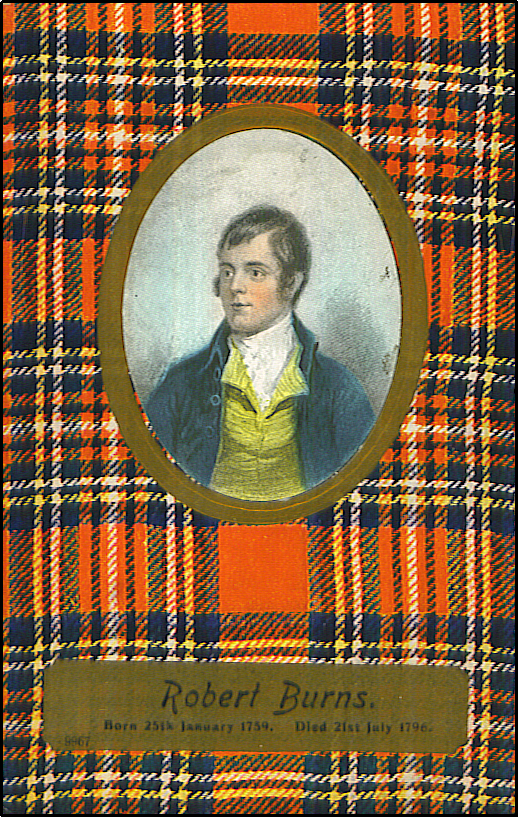
Authorized Images: Miguel de Cervantes and Luis de Camões
Miguel de Cervantes (22 pages, including 14 antique postcards); and Luis de Camões (26 pages, including 26 antique postcards).
$4.99
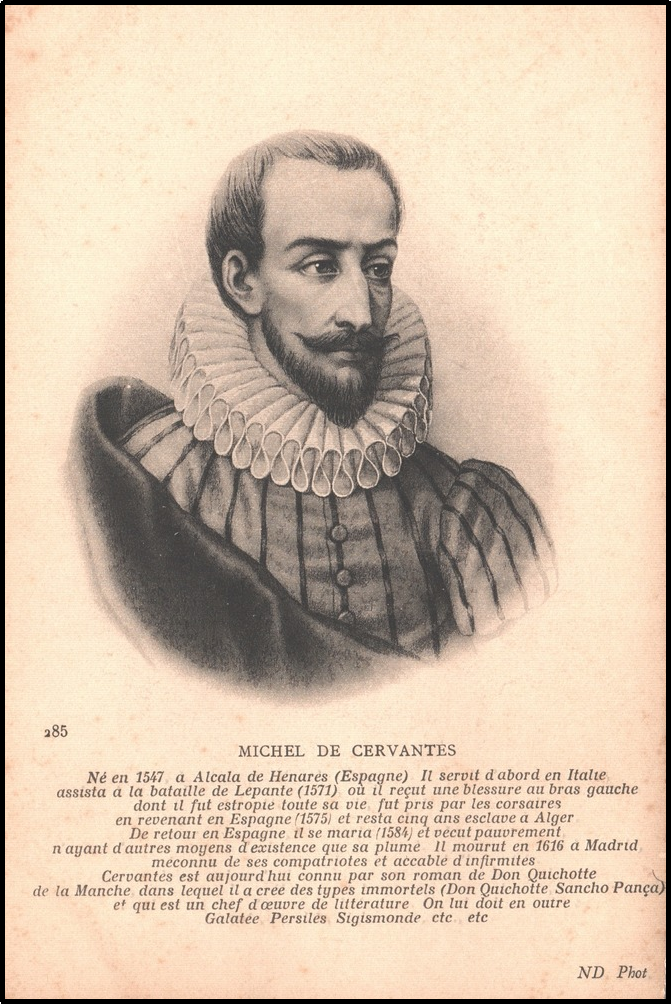
Unlike other major nations of Europe, Spain has a terrible record of honouring its most famous author. Few statues of Cervantes have ever been unveiled in the country, and its postcard publishers have been consistent in neglecting him for the most part. Indeed, the French have issued about as many postcards celebrating Cervantes and Don Quixote as have the author’s compatriots. This French postcard dates to ca 1904.

The house where Camões lived in Macau has long disappeared. However, the supposed site of his residence was commemorated ca 1886 by a bronze bust ensconced within a grotto made from artfully arranged boulders. Lines from his greatest poem “Os Lusíadas” are carved into the pedestal. The postcard above dates to about 1912.
The area around this small monument was made into a sizeable public park (named after Camões) which attracts those seeking tranquil repose amid the otherwise hectic city.
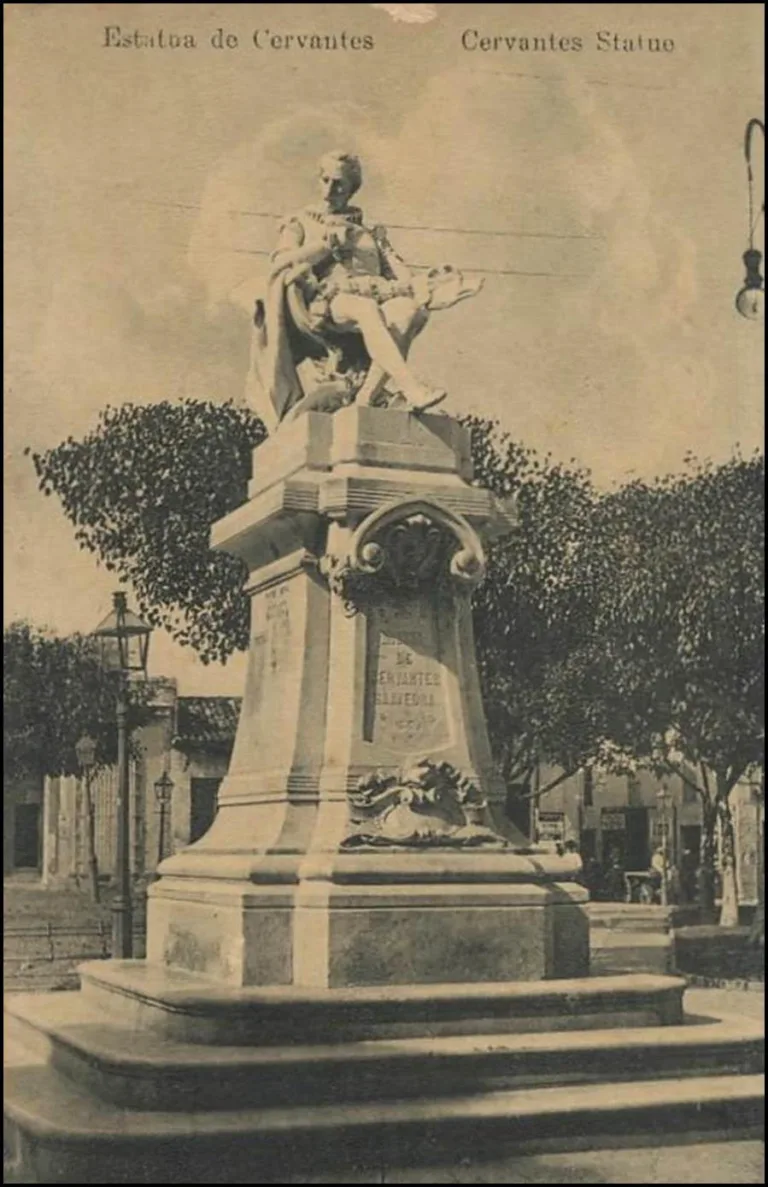
Authorized Images: Leo Tolstoy and Mikhail Lermontov
Leo Tolstoy: (125 pages, including 119 antique postcards); Mikhail Lermontov (78 pages, including 70 antique postcards). $19.99

Playwright Anton Chekhov (left) conversing with Leo Tolstoy as both convalesced in Yalta 1900-1901.
Authorized Images: Rudyard Kipling and Hall Caine
Rudyard Kipling (78 pages, including 81 antique postcards); Hall Caine (28 pages, including 23 antique postcards).
$9.99
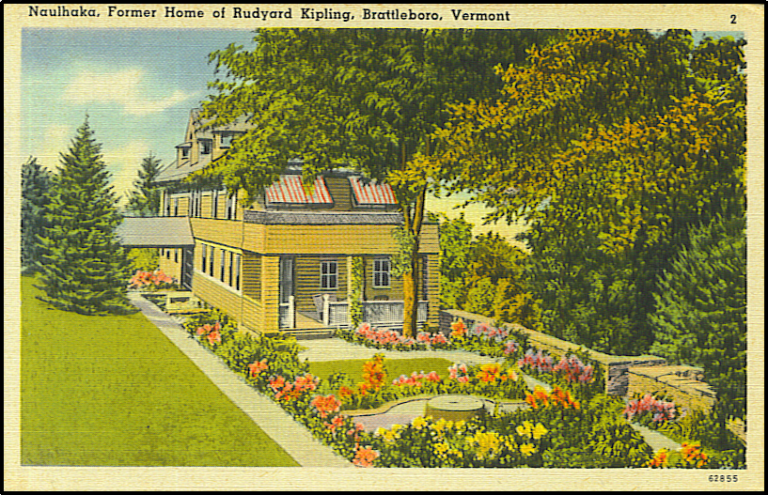
A 1930s postcard of Rudyard Kipling’s only home in the United States. Brash colours represent the decline in printing quality typical of the Depression-era years.
Authorized Images: Bjørnstjerne Bjørnson and Franz Grillparzer
Bjørnstjerne Bjørnson (32 pages, including 39 antique postcards); Franz Grillparzer (43 pages, inclduing 35 antique postcards)
$4.99

Bjørnson with his wife Karoline, standing on a balcony of their country villa in Norway.
Authorized Images: Alexandre Dumas, père and Gustave Flaubert
Alexandre Dumas, père (66 pages, including 51 antique postcards); Gustave Flaubert (92 pages, including 83 antique postcards).
$14.99
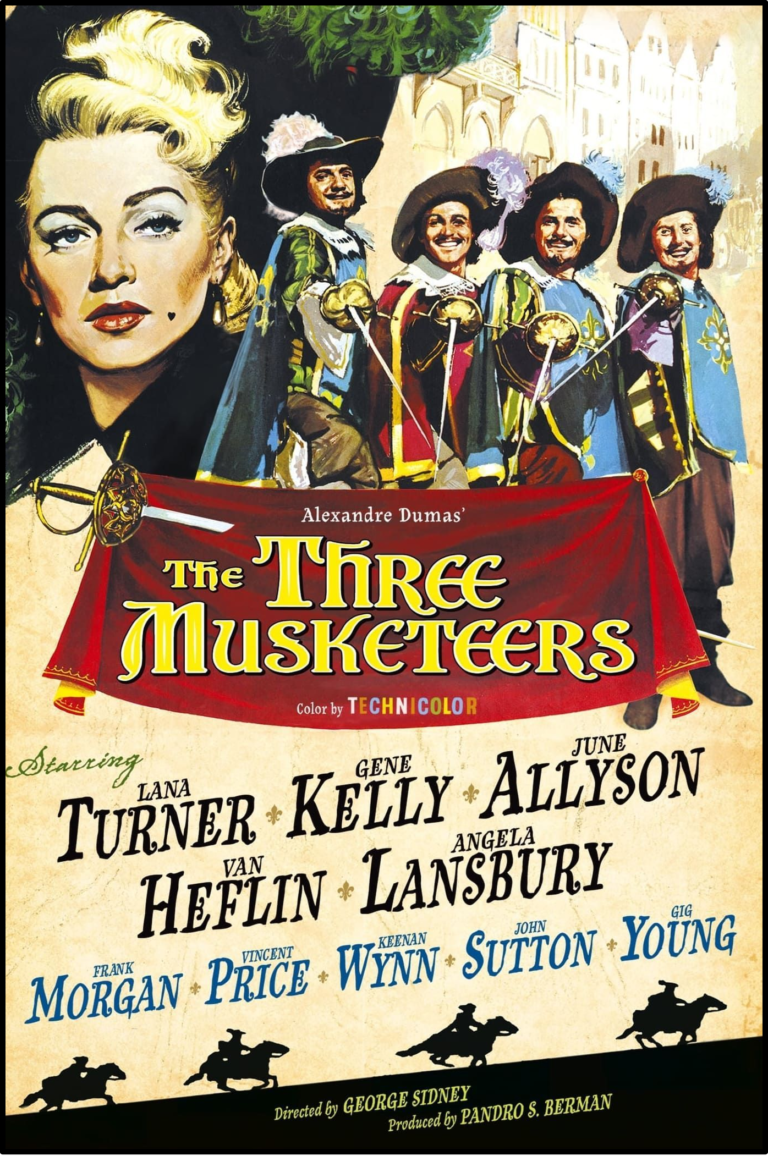

Some of the most expensive postcards ever produced were those made in the first years of the 20th c. for the up-market confectionary firm Chocolat Lombard. Their embossed postcards featured original artwork and several extra passes through the colour printing press to accommodate the many different hues used (including gold ink).
These deluxe items were reserved for customers of the company’s most expensive products. In all, only about two dozen subjects were given this elaborate treatment.
Most of these subjects were literary in nature. Interestingly, given the period, the black racial heritage of Dumas père is emphasized more than usual in his portrayal.
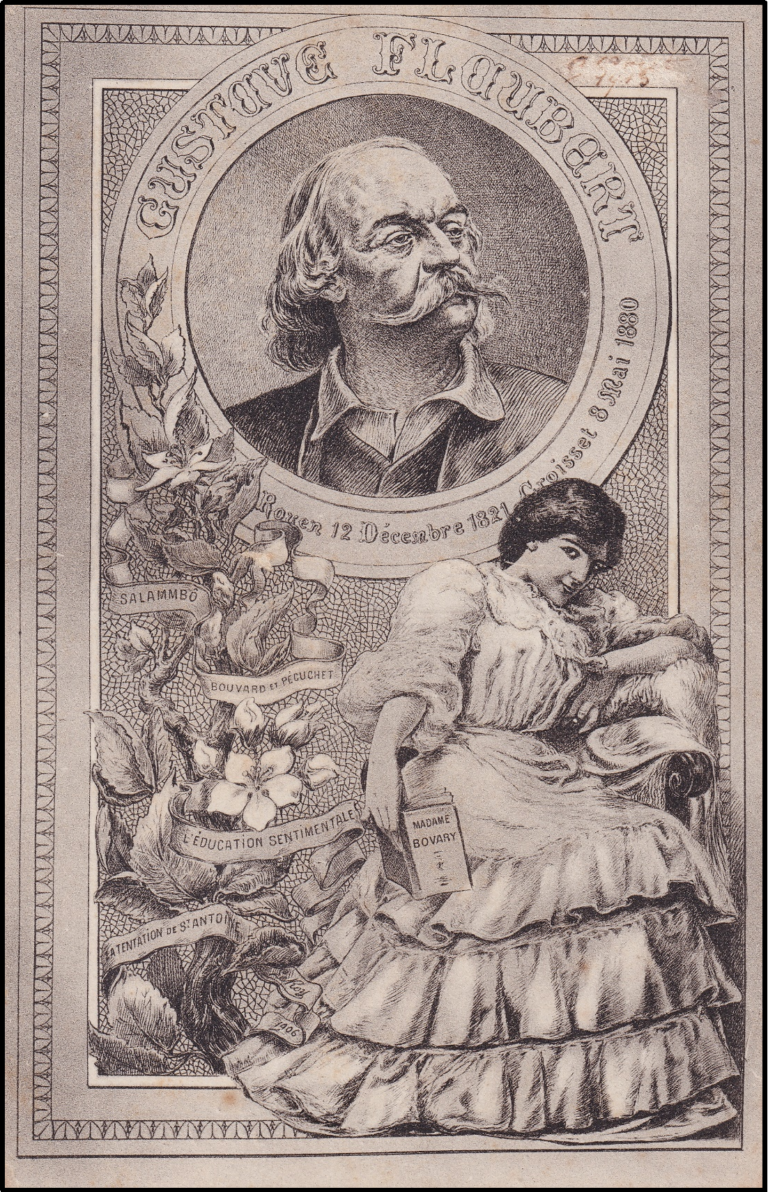
An elaborate postcard from ca 1906 of novelist Gustave Flabert, depicted with his best known fictional creation: Madame Bovary.
Authorized Images: James Fenimore Cooper, Edgar Allan Poe, William Cullen Bryant
James Fenimore Cooper (30 pages, including 22 antique postcards); Edgar Allan Poe (42 pages, including 32 antique postcards); William Cullen Bryant (28 pages, including 25 antique postcards).
$9.99

This postcard of Poe’s cottage in Fordham, New York, dates to around 1905. The image is a Real Photo Post Card and was issued about a decade later. Poe and his mother-in-law were quite content with their rental of this cottage (and with the two acres of property that went with it).
The furnishings were sparse and the second floor containing the bedrooms was not heated. Virginia, Poe’s wife, continued to decline in health. Only a few months after moving here, she died of tuberculosis, aged a mere 24.

“Large Letter Postcards” is the common name for a style which had its greatest popularity in North America and Europe within a relatively small window of time: 1938 to 1942. What makes this Large Letter Postcard of Edgar Allan Poe a highly unusual exemplar is that the image is focussed on a person. Pretty well every other Large Letter Postcard highlights a city, county, state, province, or region–never a person.

Above is an early 20th c., American postcard of the Frontier House Hotel in Lewiston, New York where Fenimore Cooper resided for several weeks in 1820 while writing his novel The Spy.
Some of the characters in the novel were based on the married couple who owned the inn. Lewiston has one further lure for visitors. It claims to be the birthplace of the alcoholic drink known as a “cocktail”. Allegedly, a local hotelier (possibly the owner of Frontier House) around 1800 began serving a mixed drink embellished, not with a stalk of celery or a tiny pink umbrella, but with a feather from the tail of a rooster.
This colourful addition by the bartender to the customer’s glass quickly became acclaimed across the region to the point that bars in other American towns duplicated the fashion, often with their own variations regarding the alcoholic and other elements of the drink. Regardless, most historians of the hospitality trade cite Lewiston as the home of the cocktail.

Bryant spent years fostering the creation of New York’s famous Central Park.
Additionally, he sat on the board that helped found the city’s medical college. He was an unapologetic New Yorker through and through, fully committed to the betterment of his adopted hometown. So much so, that, soon after his death, the City Fathers chose to name Manhattan’s most important green space (apart from Central Park itself) in honour of Bryant.
Still known as Bryant Park, the area, cornered by Fifth Avenue and 42nd Street, includes the main branch of the New York Public Library and a re-designed garden area that now makes it one of the most popular spots in central Manhattan to sit, relax, and read.
A large bronze statue of Bryant is placed among a group of statues between the library and the park’s lawn. This postcard shows Bryant Park as it was in 1915. Note the presence of streetcars—a form of public transit long gone from Manhattan.
Authorized Images: Jean de La Fontaine, Honoré de Balzac, Charles Baudelaire
Jean de La Fontaine (53 pages, including 42 antique postcards); Honoré de Balzac (88 pages, including 77 antique postcards); Charles Baudelaire (43 pages, including 31 antique postcards).
$19.99

The Palais de Justice in central Paris where the trial of Baudelaire was held August 1857 for his alleged transgression of public morals via the poems in his first book Les Fleurs du Mal.
Construction on the bridge in the foreground, the Pont au Change, was begun just as Baudelaire’s trial was ending. The sides of the bridge bear the emblem of Emperor Napoleon III, the patron of the massive rebuilding of Paris then taking place under the dictatorial direction of the Baron Haussmann.
Ironically, it was the emperor’s wife, Eugenie, to whom Baudelaire, a mere commoner, wrote, asking her to do whatever she could to reduce the fine imposed by the censorious court. Amazingly, she did intervene, and the fine was lowered from 350 francs to 50 francs.

Both Aesop and La Fontaine related this fable of the Dolphin and the Monkey.
By the time of Classical Greece dolphins were famous for saving shipwrecked sailors by carrying them to land. In this fable, during a storm, a pod of dolphins began to carry seamen ashore from a sinking vessel.
During the mayhem, one of the pod placed a pet monkey on its back, mistaking the simian for a human. As the duo approached the Greek shore the dolphin asked the monkey if it was familiar with Piraeus (the harbour of Athens). The monkey replied that he certainly was, that Piraeus was his best friend (in La Fontaine’s version the monkey confuses the village of Vaugirard with the city of Rome). The dolphin, in calmer waters near a beach, looked back at his passenger, and realized he had been deceived. He shook off the monkey leaving it to fend for itself while promptly returning to the sinking ship to save more humans. The moral: the telling of lies begets unhappy consequences for the liar.

Gaspard-Félix Tournachon (1820–1910), the most famous photographer of the 19th century eminences of the arts in Paris, practiced under the pseudonym “Nadar”.
In addition to photography, he excelled at hot-air ballooning—indeed, combined these two talents to take the first aerial images of the French capital.
Baudelaire sat for Nadar on more than one occasion. The best image from an 1862 session was reproduced on a WWI-era postcard (above)

The rise in the popularity of motoring in the early 20th c. led to the invention of a new species of postcard—of which the item above is a good example. As people routinely began to travel in their cars over greater distances than they had previously (when horses were the usual means of transport power) they wanted souvenirs of the relatively faraway places their automobiles had taken them. Publishers happily fulfilled this new need with postcard-maps of each of the nearly 100 departments of France.
Every example of this type of card features a cameo of just one or two famous people who had lived in the department—and in nearly every case the portrait of a famed literary author was selected for inclusion.
Here, the mathematician Nicolas de Condorcet shares top billing with Jean de la Fontaine.

Auguste Rodin had many challenges in portraying Balzac.
First, he had never met the man.
Second, there were few drawings of the writer and only one daguerreotype existed.
Third, Balzac was short and chubby with a big pot belly, hardly the physique associated with a heroic figure deserving of a 3-meter-high public statue.
After many trials and approaches, Rodin chose to portray his subject symbolically, as a figure full of explosive, revolutionary energy.
Today, this treatment is regarded as genius by most art critics, but in 1898 the majority of observers were appalled by what they saw.
Angered by the public response, and not mollified by the vigorous support he received from a modicum of celebrities from the visual arts and literary worlds, Rodin moved his life-sized plaster cast to his huge studio, and refused all requests from buyers for a bronze casting. In fact, Rodin never saw his sculpture in bronze because it was not rendered in that metal until 1939.
That first metallic casting was unveiled at the intersection of Blvd. Raspail and Blvd. du Montparnasse in Paris. Since then, the Rodin Estate has authorized about a dozen further casts in bronze, all now found in major museums around the world.
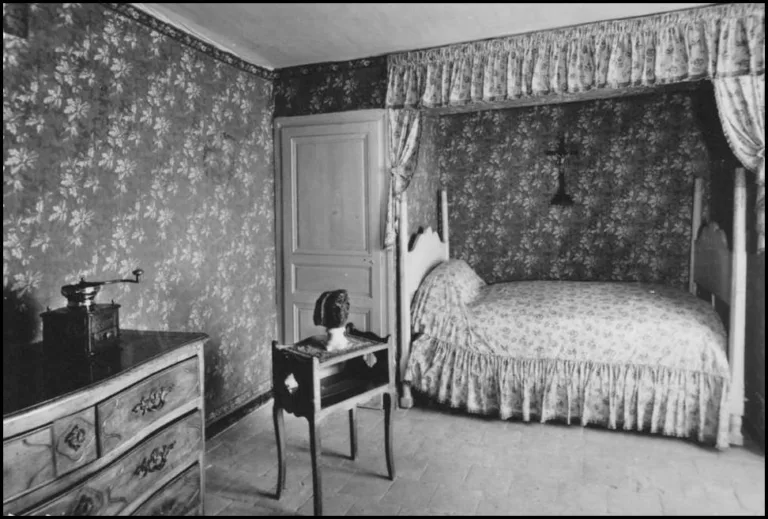
Balzac’s bedroom on the second floor of the Chateau de Saché.
The museum curators here have placed on top of the dresser a coffee mill like the one used by Balzac while he wrote.
It is estimated that the author daily drank around 40 cups of black coffee over a 24-hour period. Ordinarily he wrote every evening (using a quill pen) between midnight and eight o’clock in the morning, though there were many times, if the words were flowing, he kept writing until he collapsed into sleep.
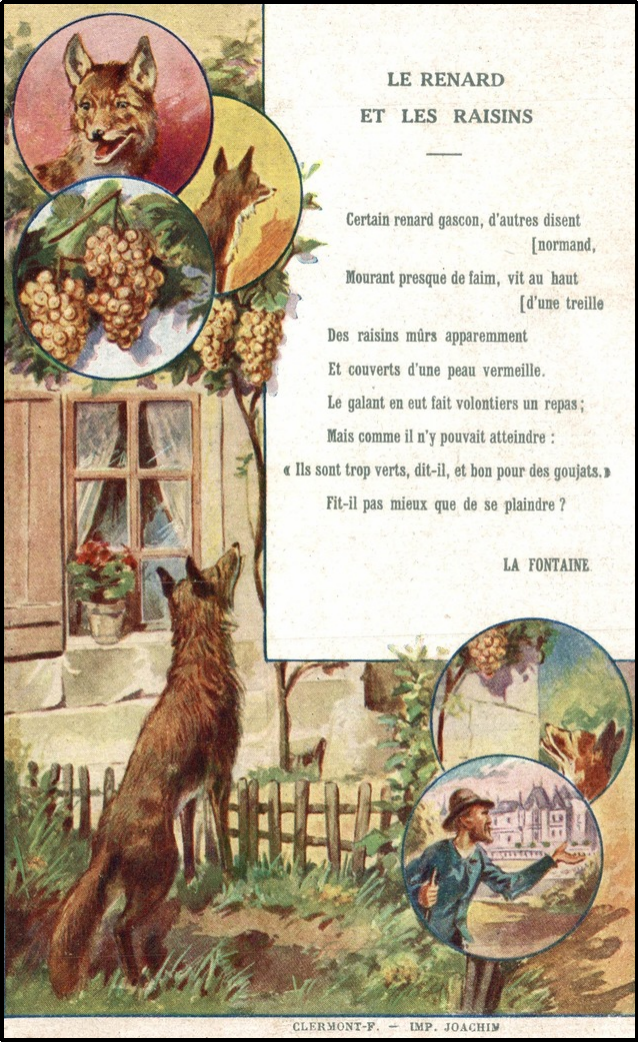
The Fox and the Grapes
Authorized Images: Lord Byron, Percy Bysshe Shelley, John Keats
Lord Byron (98 pages including 62 antique postcards); Percy Bysshe Shelley (55 pages, including 45 antique postcards); John Keats(44 pages, including 35 antique postcards).
$14.99

Here is an example of Literary propaganda at its best—or worst. In this early 20th c postcard, Lord Byron is portrayed as the loving father of his little girl Allegra, a child for whom he would do anything.
The truth was rather more unpleasant. No sooner had Byron taken custody of the child than he parked her in a series of foster homes before ultimately committing her to a nunnery.
There, when only five years old, she died. For unbearable pathos it is difficult to surpass the letters little Allegra wrote to her daddy, asking him to please, please, please visit her at the convent located only a few kilometers from his residence.
Byron could hardly claim poverty as an excuse for his neglect because, in 1817, the year of Allegra’s birth, he had sold his country home, Newstead Abbey, for a fortune.
Indications are that it was Byron’s most recent mistress in Venice, rather than Byron himself, who visited the child at the convent.

A view of the Chateau de Chillon (which Byron visited and by which he was inspired to write his famous poem “The Prisoner of Chillon”). This perspective shows how well the fortress was protected on three sides by the waters of Lake Geneva. The postcard above dates from about 1904.
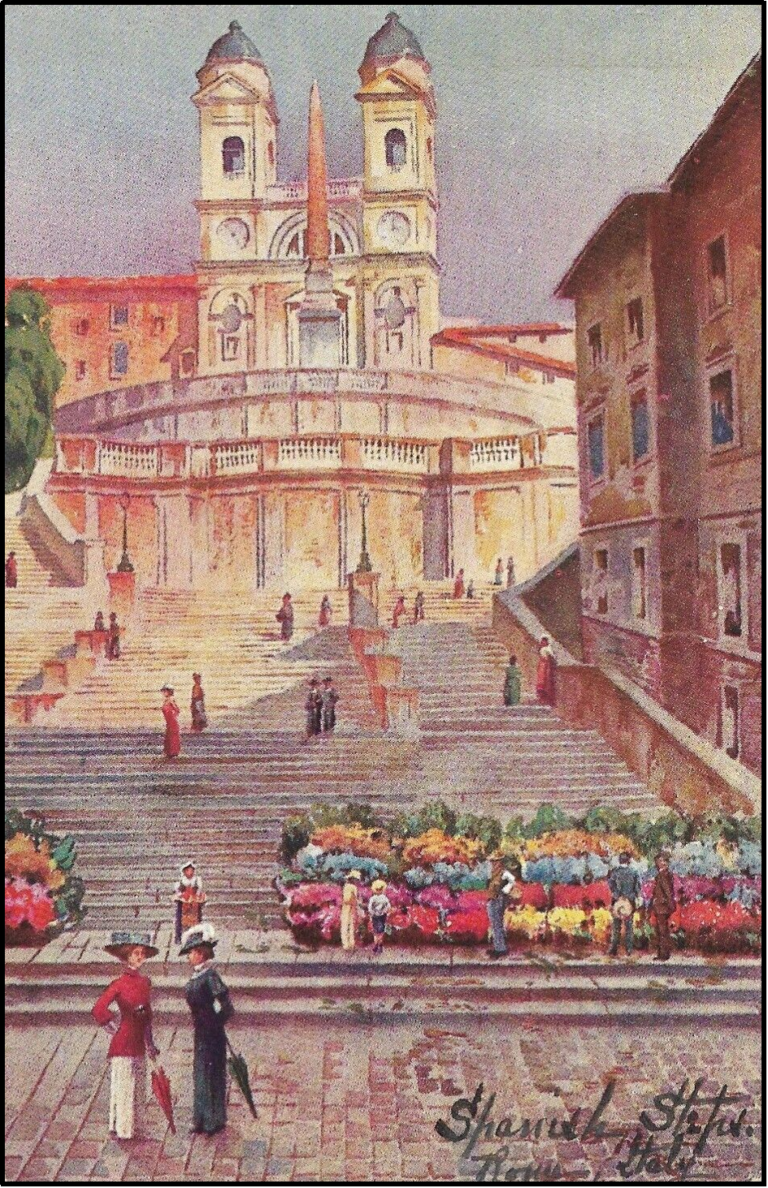
Authorized Images: Homer, Sappho, Aeschylus
Homer (85 pages, including 57 antique postcards); Sappho (35 pages including 31 antique postcards); and Aeschylus (25 pages including 19 antique postcards).
$14.99
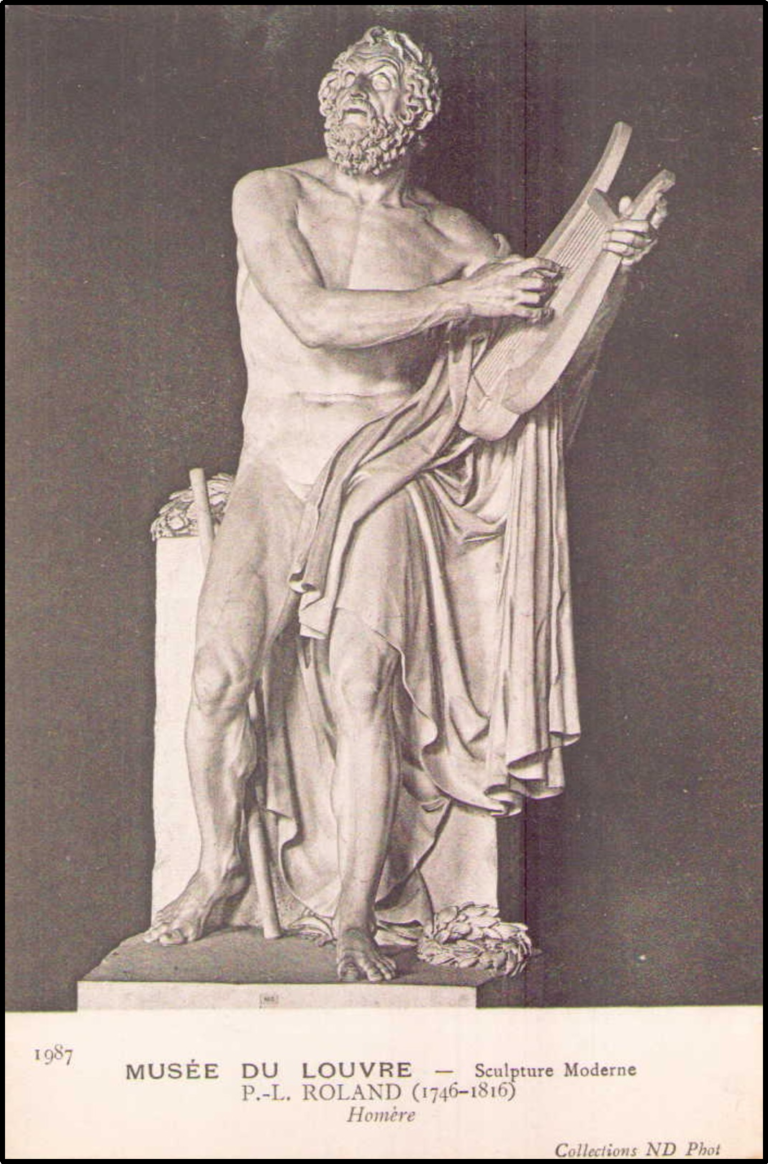
A slightly over life-sized statue of Homer (with traditional lyre) now resides in the Louvre Museum in Paris. The marble sculpture, carved in 1812, was the work of Philippe-Laurent Roland (1746-1816). The postcard was issued by the French studio Nurdein ca 1908.
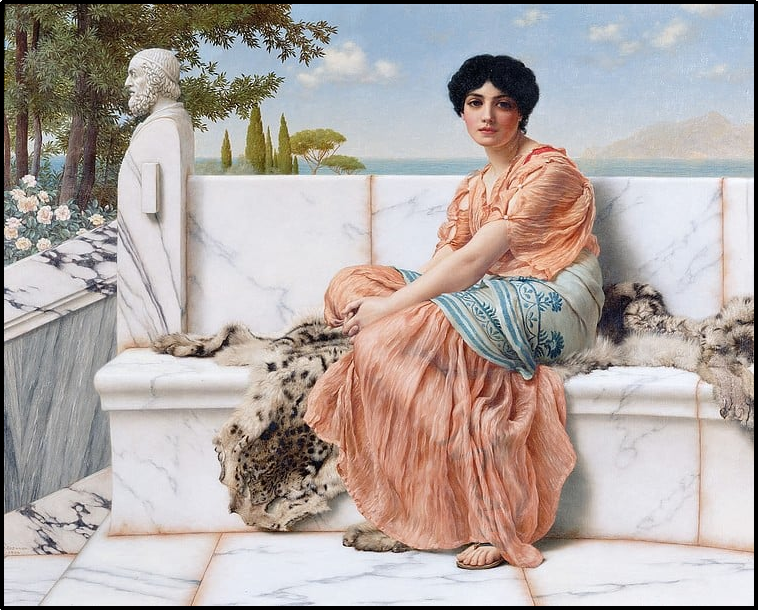
“The Time of Sappho”, a 1904 oil on canvas by John William Godward (1861-1922). Most of Goodward’s oeuvre is in the Neo-Classical style of the antique postcard above. The public and critics regarded him as almost embarrassing because he was so out of step with the dominant taste for Impressionist and other newer schools of art. It is claimed that when he took his own life, his suicide note read “the world is not big enough for [both] myself and a Picasso”.
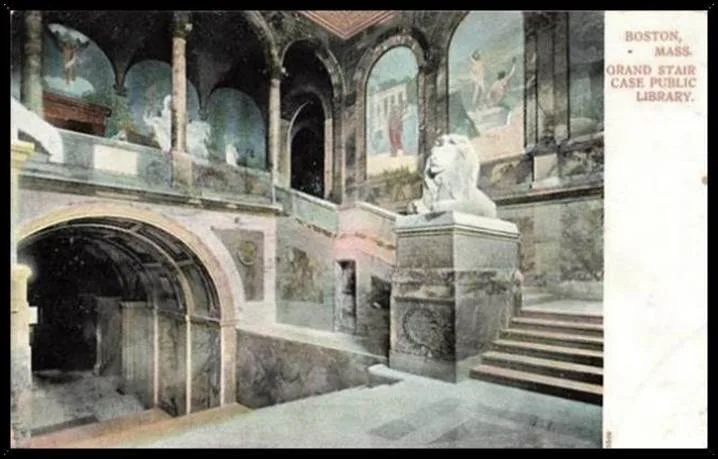
In 1891 the French Symbolist painter Pierre Puvis de Chavannes (1824-1898) received a commission from one of the most famous architectural firms in the history of the USA, McKim, Meade and White, to paint several murals for a room of the Boston Public Library.
Chavannes answered the challenge in 1895 with images representing several branches of knowledge, including Astronomy, Physics, Philosophy, History, and Poetry. For the latter he depicted three subdivisions of the literary art form: Pastoral Poetry (represented by Virgil), Dramatic Poetry (Aeschylus), and Epic Poetry (Homer).
For the latter he portrayed Homer in old age, seated on a rock, about to be awarded victory laurels by personifications of the Iliad and the Odyssey.
Above is a postcard (ca 1910) of the three personifications of Poetry by Chavannes adorning the Grand Staircase Hail.

Aeschylus account of the tragedy of Prometheus via his play “Prometheus Bound” has, through the centuries, had a generous effect on the imaginations of visual artists, especially sculptors. Probably the most viewed of these three-dimensional representations is the gilded statue of the Titan gracing Rockefeller Place in central Manhattan (seen above in a postcard from the late 1940s).
The depiction of the fallen god is the work of American Paul Manship (1885-1966). The connection between the sculpture and the classical playwright is made overt by Manship’s insistence that the following quotation from the Greek drama be carved into the red granite which acts as a backdrop to the main figure: “Prometheus, Teacher in Every Art, Brought the Fire That had Provided to Mortals a Means to Mighty Ends”.
The likeness of Prometheus forms the centerpiece of the fountain dominating the lower square of the Rockefeller Plaza. Civic authorities assert that this is the most photographed sculpture in New York City. Manship’s sculptural portrayal, made of bronze, was unveiled in 1934. It stands 18 ft (5.5 m) tall and weighs 8 tons. The figure falls through a large ring adorned with the signs of the zodiac, a device indicating the heaven from which Prometheus has fallen. He tumbles toward a mountain symbolizing Earth.
Authorized Images: Elizabeth Barrett Browning, Robert Browning, Matthew Arnold
Elizabeth Barrett Browning and Robert Browning (63 pages, including 42 antique postcards)’ Matthew Arnold (11 pages, including 9 antique postcards).
$9.99

“Hope End”, the home of Elizabeth Barrett between 1809 and 1831. Her home tutoring took place entirely at Hope End, an education which allowed her to read English literature extensively, learn classical Greek and Latin, and write poetry without being reproached for it.
The mansion was destroyed by fire in 1910. This postcard of the estate was published about half-a-decade before the fire.

A UK postcard, circa 1908, of an 1859 sketch by an unknown artist of Barrett Browning. The drawing closely follows a photograph widely disseminated across the Empire and the United States during the Belle Epoque.

This postcard celebrating Robert Browning’s association with Ca’ Rezzonico in Venice was published ca 1904—that is, a mere 15 years after his death.
Authorized Images: Walt Whitman, Emily Dickinson, Henry Wadsworth Longfellow
Walt Whitman (36 pages, including 31 antique postcards); Emily Dickinson (8 pages, including 4 antique postcards); and Henry Wadsworth Longfellow (267 pages, including 287 antique postcards).
$24.99
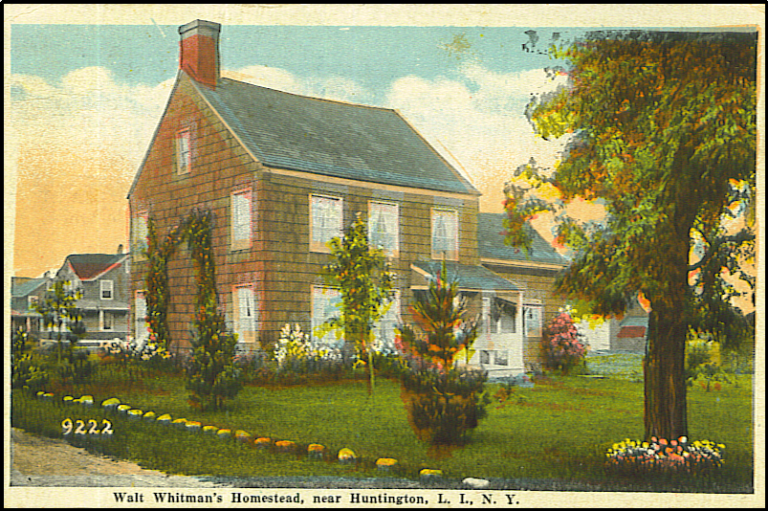
As New York City expanded, what had once been open countryside on Long Island became denser with suburban properties. Fortunately, someone chose to renovate and refurbish the Whitman house in West Hills on the island rather than demolish it. The postcard above dates to ca 1915.
Authorized Images: J.M. Barrie, Thomas Hardy, Agatha Christie
J.M. Barrie (63 pages, including 70 antique postcards); and Thomas Hardy (52 pages, including 45 antique postcards); and Agatha Christie (38 pages, including 23 antique postcards).
$14.99

J.M. Barrie, ca 1902, from a postcard issued within a a year or so of the first appearance of the photograph.

The bronze statue of Peter Pan erected in Kensington Gardens, London, as seen shortly after 1912 when the likeness was unveiled. The artist’s fee and the cost of the casting were paid for completely by J.M. Barrie.

Hall Caine seen in business attire in a hand-tinted postcard from about 1902. However, when he was at home penning his novels, Hall Caine, like Mark Twain, often chose to write while seated upright in bed. And, like Twain, he was not shy about being photographed (and even filmed) at that task, sometimes while wrapped in a thick bathrobe.
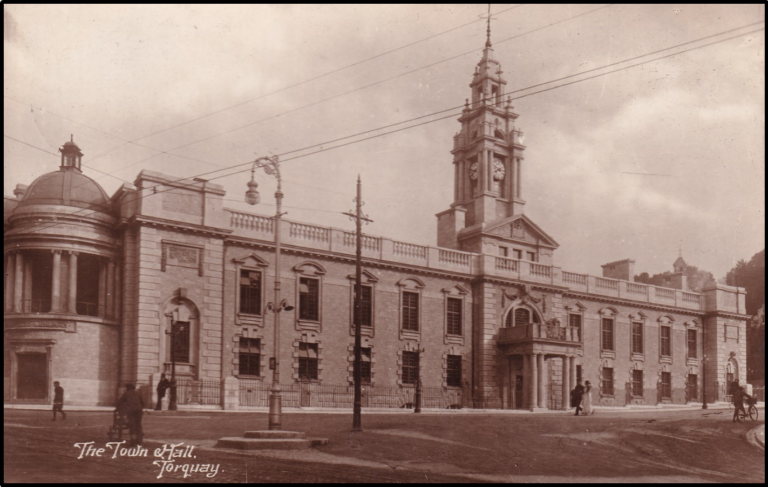
The Torquay Town Hall, above, circa 1912, its interior modified during the Great War to be a hospital by the Red Cross. Agatha Christie began working here as a nurse’s aide. A year later she had qualified as a nurse. She also trained to be an assistant to a chemist (i.e., a pharmacist) which resulted in her being assigned to fulltime duties in the dispensary. Her job for two years, this is where she acquired most of her knowledge about poisons—those lethal elixirs that are the agents of death in so many of her novels. Any knowledge about dastardly potions she did not obtain during the First World War she gained in the Second when, again, she worked in a hospital dispensary.
Authorized Images: Ludovico Ariosto, Torquato Tasso, Giovanni Boccaccio, Pietro Aretino
Ludovico Ariosto (29 pages, including 25 antique postcards); Torquato Tasso (46 pages, including 42 antique postcards), Giovanni Boccaccio (38 pages, including 31 antique postcards); and Pietro Aretino (6 pages, including 3 antique postcards).
$19.99
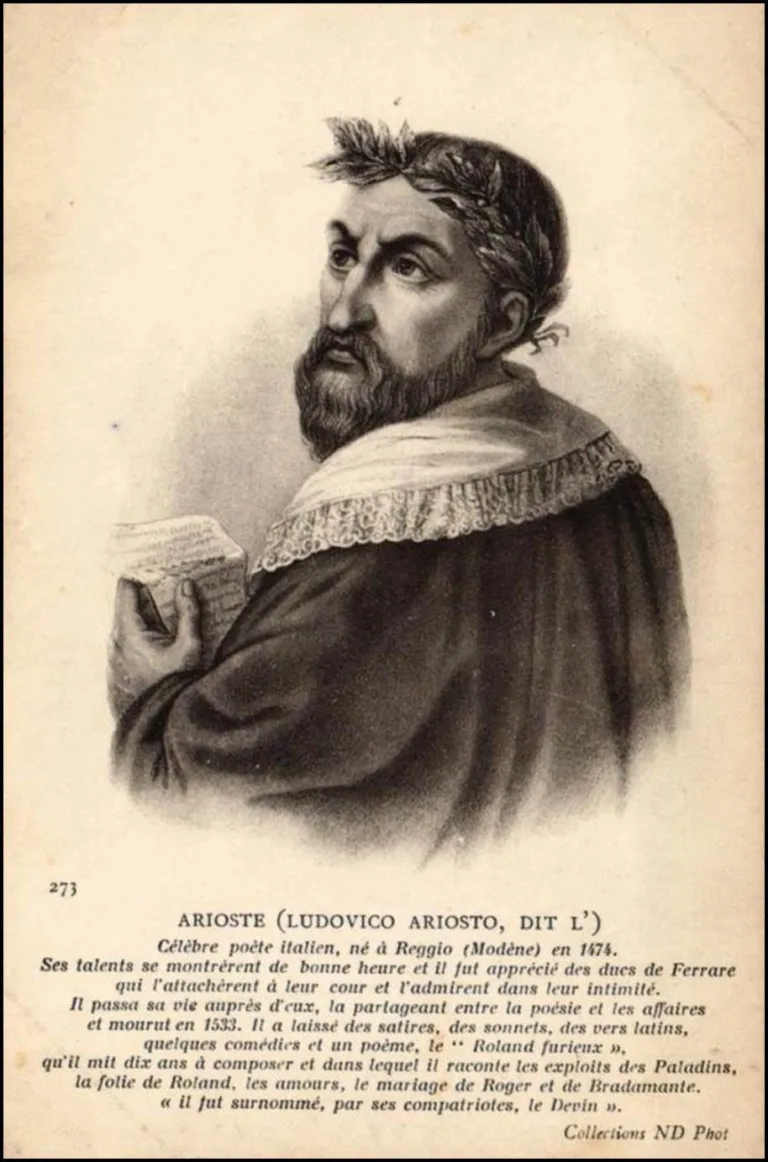
The Neurdein Photography Studio began as a family-run firm in 1864 in Paris. In addition to making photographic portraits of individuals, the firm also produced cartes-de-visite, magic lantern slides, and stereo-view-cards.
Towards the end of the 19th c. two Neurdein brothers became early pioneers in engaging with the new phenomenon called “picture postcards”. Around 1900 they initiated a series of hundreds of postcards of famous people, all the cards using the same format; a black-and-white, two-dimensional bust supported by approximately 100 words of biography. This proved an extraordinarily successful formula as the studio sold hundreds of thousands of these cards in the first three decades of the new century.
This format also allowed Neurdein to easily license the reprinting of certain cards to foreign postcard-makers. Foreign printers merely had to replace the French biographical text with similar text in their own language while leaving the portrait intact. The postcard above dedicated to Ariosto dates to about 1903.
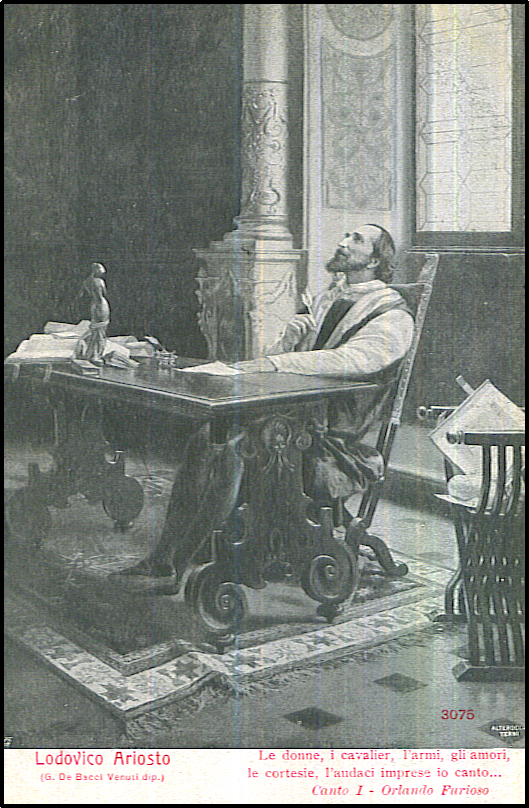
An Italian postcard (published circa 1905) of a painting by Gualtiero de Bacci-Venuti had many admirers. Bacci’s portrayal of Ariosto unwittingly reflects a common, nineteenth-century belief: that great authors must constantly be having Deep Thoughts while alone in their studios, looking up to the heavens for inspiration.

Inhabitants of Arezzo are noted for their pride in calling the city their hometown. One postcard publisher, about the year 1903, hoping to capitalize on that fervor, issued this postcard of celebrated residents. Pietro Aretino is awarded pride of place in the top row, left.
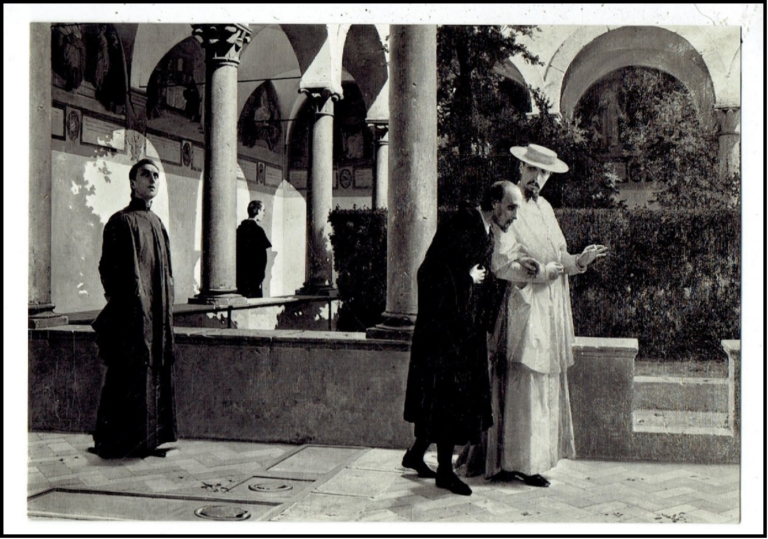
Early 20th c. postcard of a painting by Luigi Busi (1837-1884) of an aged and very ill Torquato Tasso holding for support the arm of a senior cleric as they walk in the cloister of the monastery of S. Onofrio where the poet died.
Authorized Images: Molière, Pierre Corneille, Pierre Beaumarchais, Pierre Abelard
Molière (100 pages, including 60 antique postcards); Pierre Corneille (93 pages, including 111 antique postcards); Pierre Beaumarchais (17 pages, including 13 antique postcards); Pierre Abelard (35 pages, including 28 antique postcards).
$19.99
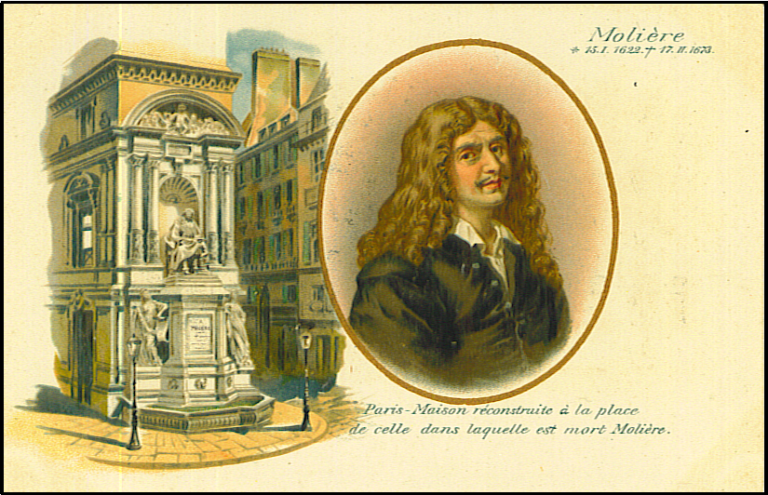
The largest and most impressive monument created in memory of Molière is the huge fountain erected in central Paris named after him. Above is a lithographed postcard showing the fountain and a cameo of the author, dating to 1897.
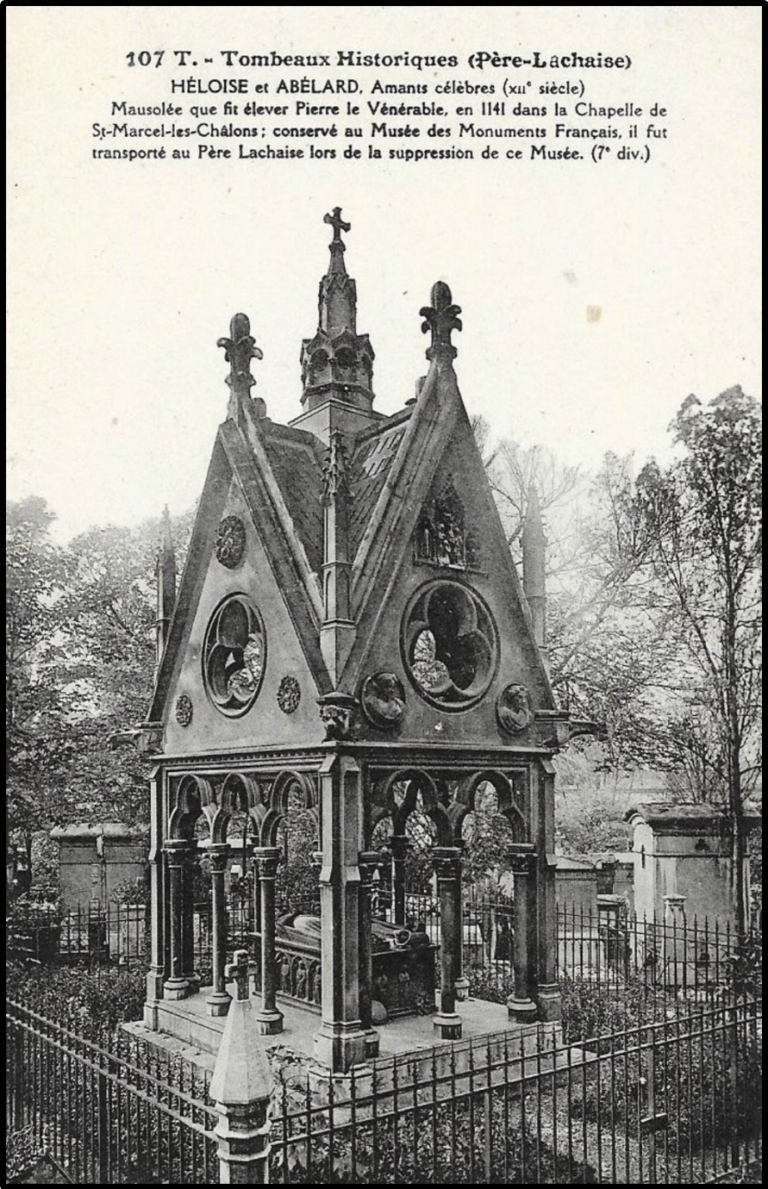
The tragic yet compelling account of the affair between Heloise and Abelard is one of the greatest true-life love stories in history. The couple were famous in France in the 11th century and have been so ever since. The current tomb, seen here in a 1902 postcard, was erected in 1800 and holds the remains of the devoted pair.
Authorized Images: Jane Austen, George Eliot, Charlotte Bronte, Anne Bronte
Jane Austen (23 pages, including 17 antique postcards); George Eliot (43 pages, including 38 antique postcards); Charlotte Bronte (45 pages, including 38 antique postcards); Anne Bronte (19 pages, including 12 antique postcards).
$12.99
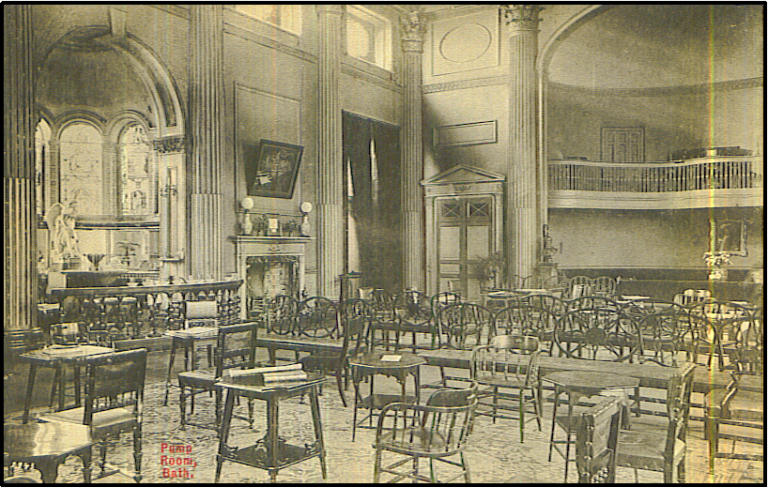
The dining area of The Pump Room, a popular meeting place for residents of Bath, England. What we would now call palm-court orchestras played light music as background for patrons having tea and snacks. The bands played in the balcony (upper right, delineated by a balustrade). Jane Austen set important scenes in her novels Northanger Abbey and Persuasion in this room
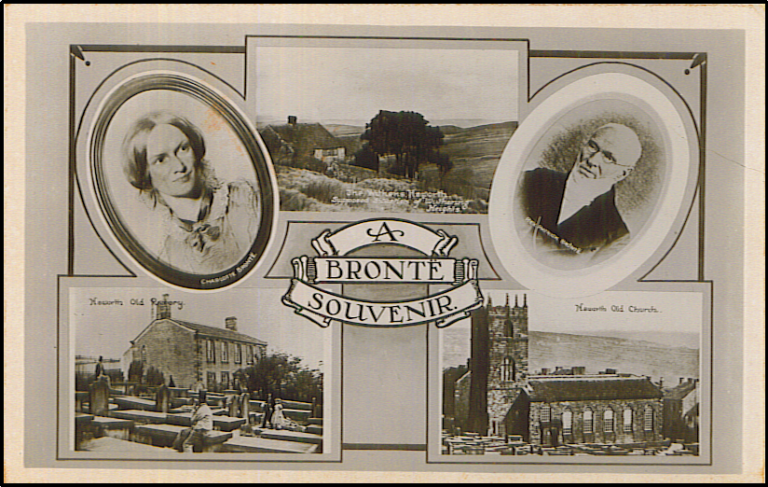
Above is a postcard from the first decade of the 20th c. Among the photos in this mosaic are cameos of Charlotte Bronte and her father, an Anglican minister. The montage also has images of the church where he presided, of the pastor’s house where the Bronte family dwelled, and of the moors which so influenced her writing.
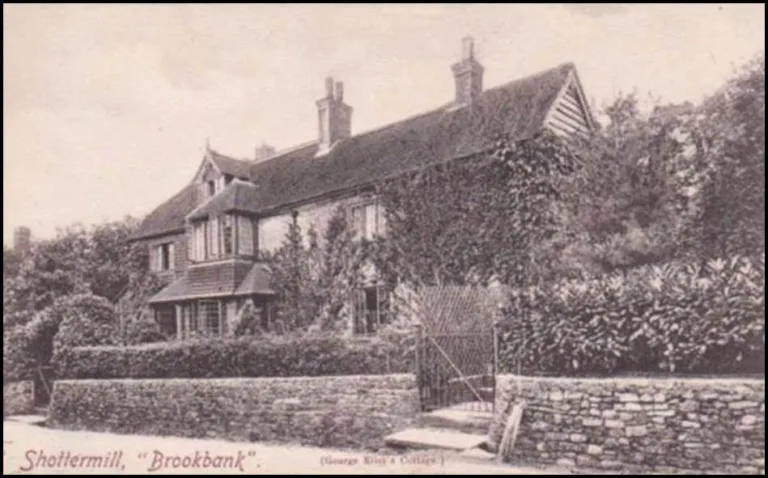
Brookbank (above), built in 1730, has many literary associations.
Dante Gabriel Rossetti and Alfred Tennyson stayed here on several occasions (at different times) as the house guest of Anne Gilchrist, widow of Alexander Gilchrist, the biographer of poet William Blake.
Anne wrote the first important essays in England about Walt Whitman’s work after she was thunderstruck reading “Leaves of Grass” shortly after its publication. Her effusive response led to a long correspondence with Whitman and the two remained friends for life. Christina Rossetti also befriended Anne Gilchrist and would stay for long periods at Brookbank working on her poems and tales for children.
Today, the house is most celebrated for having been rented in 1871 by Mary Ann Evans and George Lewes. They remained here for about half a year while their home in London was undergoing extensive renovation. George Eliot wrote large parts of Middlemarch while at Brookbank. This postcard of the house is from the years 1903-1908.
Authorized Images: Ralph Waldo Emerson, Nathaniel Hawthorne, Louisa May Alcott, Henry David Thoreau
Ralph Waldo Emerson (58 pages, including 63 antique postcards); Nathaniel Hawthorne (42 pages, including 40 antique postcards); Louisa May Alcott (35 pages, including 35 antique postcards); and Henry David Thoreau (36 pages, including 26 antique postcards).
$19.99

A postcard (above), ca 1906, of the Minute Man statue at Concord, Massachusetts, now a National Historic Park. The bronze statue by Daniel Chester French was unveiled in 1875. The figure depicts a young farmer setting aside his plow to go with his gun to fight the British foe.
Minute men were the finest of the militia available to George Washington when the war with Great Britain started. They were selected by senior professional soldiers who had observed with pleasure the physical fitness and musketry skills of this elite group.
These American warriors were expected to report for duty at a metaphorical minute’s notice. Ideally, they were further expected to be the first troops at a battle site. Paradoxically, a corps of Minute Men was the invention of the British Army in the 17th century.
Unable to protect its American colonies with the few fulltime troops available, the Imperial Army HQ in London authorized the creation of a highly mobile and dangerous force to protect British colonists from attacks from the French to the north, native Indians to the west, and fomenters of public unrest anywhere in North America where the Union Jack flew.

Although he is one of America’s greatest novelists of the 19th c., there seems to be only one major statue in the United States erected in his honour. Appropriately enough, this statue (above) is in Salem where Hawthorne once worked and lived.
The bronze, sitting on a granite base, is the work of American artist Bela Pratt (1867-1917). The statue, unveiled in 1913, originally sat for a dozen years in Boston at the Museum of Fine Arts. In 1925 it found a new home in Salem.
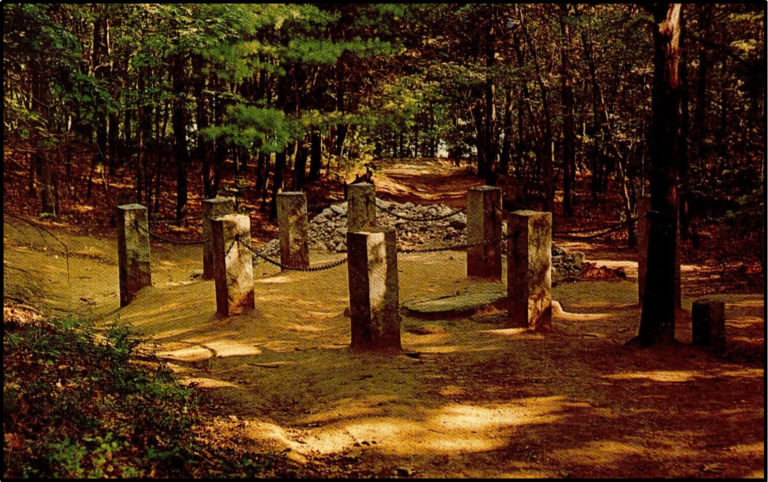
Authorized Images: F. Scott Fitzgerald, Oren Arnold, Sholem Aleichem, Ernest Hemingway
Scott Fitzgerald(48 pages, including 30 antique postcards); Oren Arnold(16 pages, including 13 antique postcards); Sholem Aleichem (16 pages, including 12 antique postcards); Ernest Hemingway (65 pages, including 53 antique postcards).
$19.99

This handsomely framed 1920s postcard celebrates the leading Yiddish authors of that time. In the centre of this mosaic is Mendele Mocher Sforim.
Clockwise from top let, are Isaac Peretz, Sholem Aleichem, novelist Jacob Dinezon (1851-1919), poet David Frischman (1860-1922), poet Simon Frug (1860–1916) and the dramatist Shloyme Ansky (1863-1920), author of “The Dybbuk”, the most popular play in either Yiddish or Hebrew of the 20th c.

The Country Club in Montgomery, Alabama where F. Scott Fitzgerald first met Zelda Sayre who, with time, became his wife. This postcard is coincident with the year in which the two met at a dance hosted by the club so that soldiers at a nearby WWI army base (where Fitzgerald was enlisted) could mingle with southern belles.
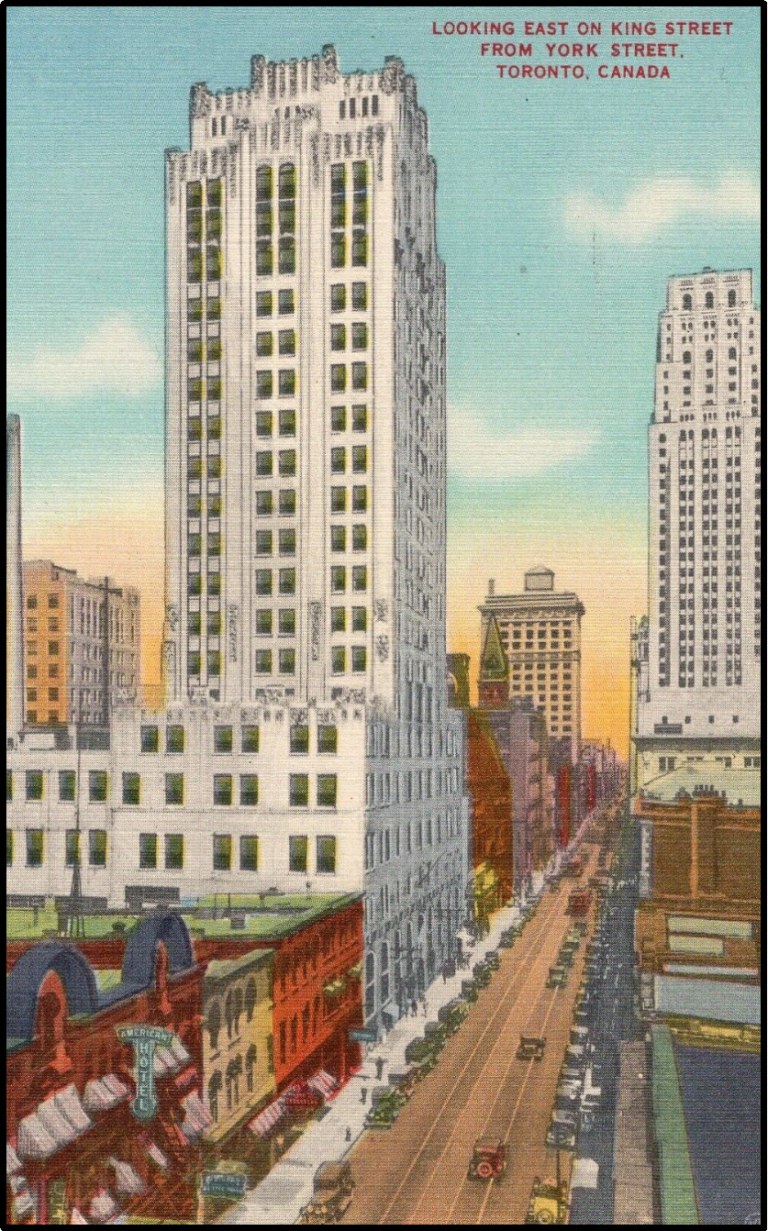

This 1960s postcard captures the only time Hemingway met Fidel Castro in person. The encounter took place in May 1960 in Cuba at a sport-fishing competition named after the famous American author by the island’s revolutionaries to honour Hemingway’s long association with the country which had become Hemingway’s second home.
Authorized Images: Caedmon, Geoffrey Chaucer, John Milton, John Bunyan
Caedmon (15 pages, including 14 antique postcards); Geoffrey Chaucer (18 pages, including 13 antique postcards); John Milton (66 pages, including 45 antique postcards); and John Bunyan (33 pages, including 38 antique postcards).
$19.99
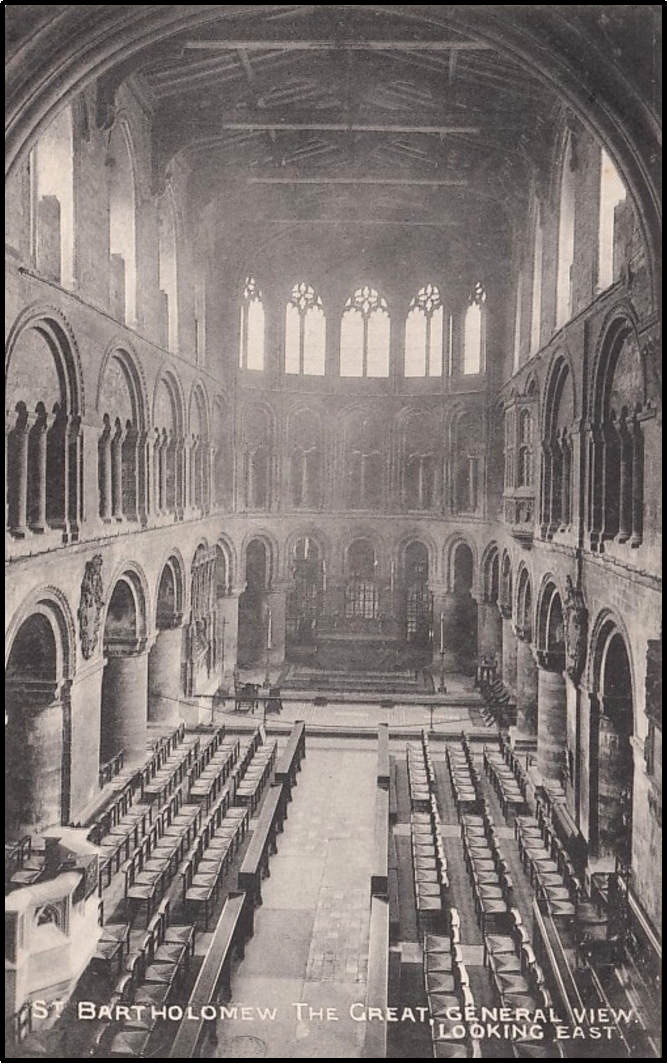
After the return of Charles II to the English throne, Milton, no longer able to work (because of his politics) for the government as he had before, moved to the London parish of Saint Bartholomew, the interior of the church little changed since John Milton made this his main place of worship. This postcard dates to ca 1910.
